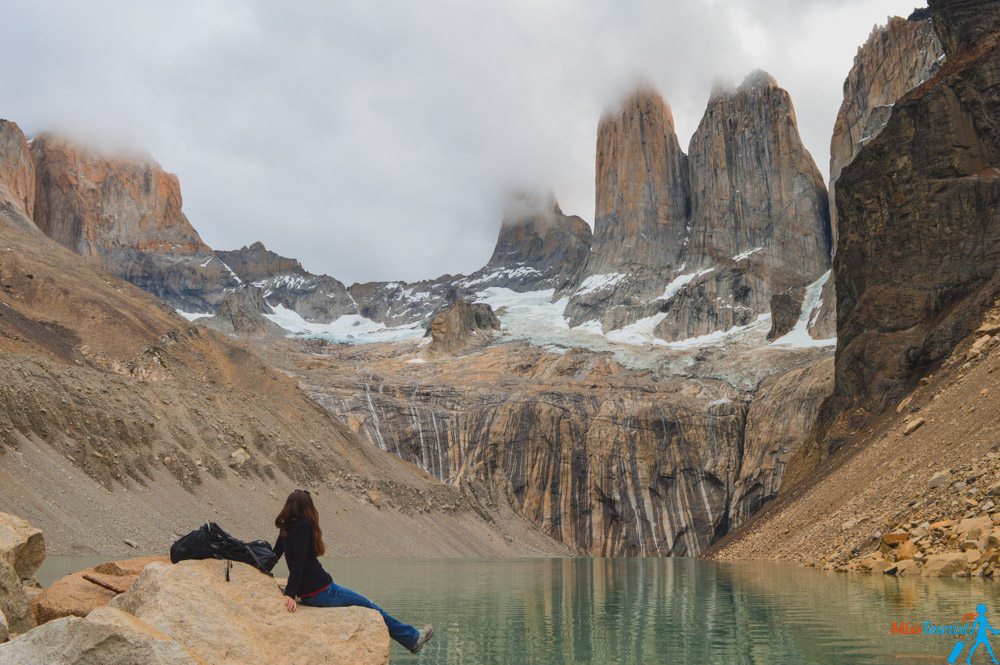
The Torres del Paine trek, located deep in the south of Patagonia in South America, is considered to be one of the best treks in the world!
I was always curious if that was true and I didn’t want to miss the chance to hike the famous park myself while I was touring the continent!
There are many blog posts and books out there with the aim of helping you prepare for this trek, but I found they missed some important information. Thus, in order to help you plan your trip and cover all the questions I had and the answers that I could not find on the internet before, I decided to write my own Torres del Paine trekking guide!
These are the questions you need to ask yourself BEFORE going to Torres del Paine, aka Gulf of Paine, in order to have a great time there. I counted 5 of them, but you can also find an FAQ section at the end of the article with some more important things you should keep in mind!
Contents
1. Should you go in the summer or in the winter?
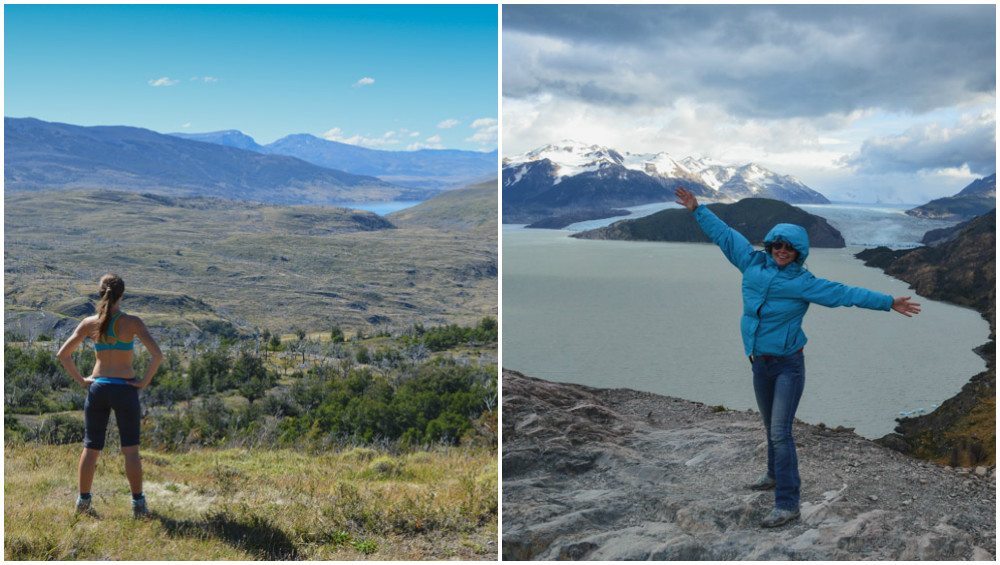
The weather in Patagonia is so unpredictable, it can compete with Iceland! A hot sunny day can change to a cold one with strong wind gusts which will blow you away in the blink of an eye.
Even though you cannot predict the weather, you can at least choose the season, so you should think this through before planning your trip. So, when should you go to Torres del Paine?
October to April is considered to be a good time to visit. That is when spring and summer are in the southern hemisphere, but being far south, they don’t last as long as you’d like. Winter comes to Torres del Paine, Patagonia after April, and, believe me, it is cold. And by cold, I mean Russian-winter-cold (I am Russian, so I should know!). 🙂
If you are an experienced hiker searching for a challenge, then you can go in the winter as well. But it also sometimes got really windy in February (summer) when I went. And by really windy I mean that I could barely stand on my own two feet! So I can only imagine how windy is it during the winter in Torres del Paine!
If you ask me, the only advantage to going in the cold season (May to August) is that there are hardly any tourists.
You can find more information about the weather in Torres del Paine here.
2. O or W, or maybe the Q trek?
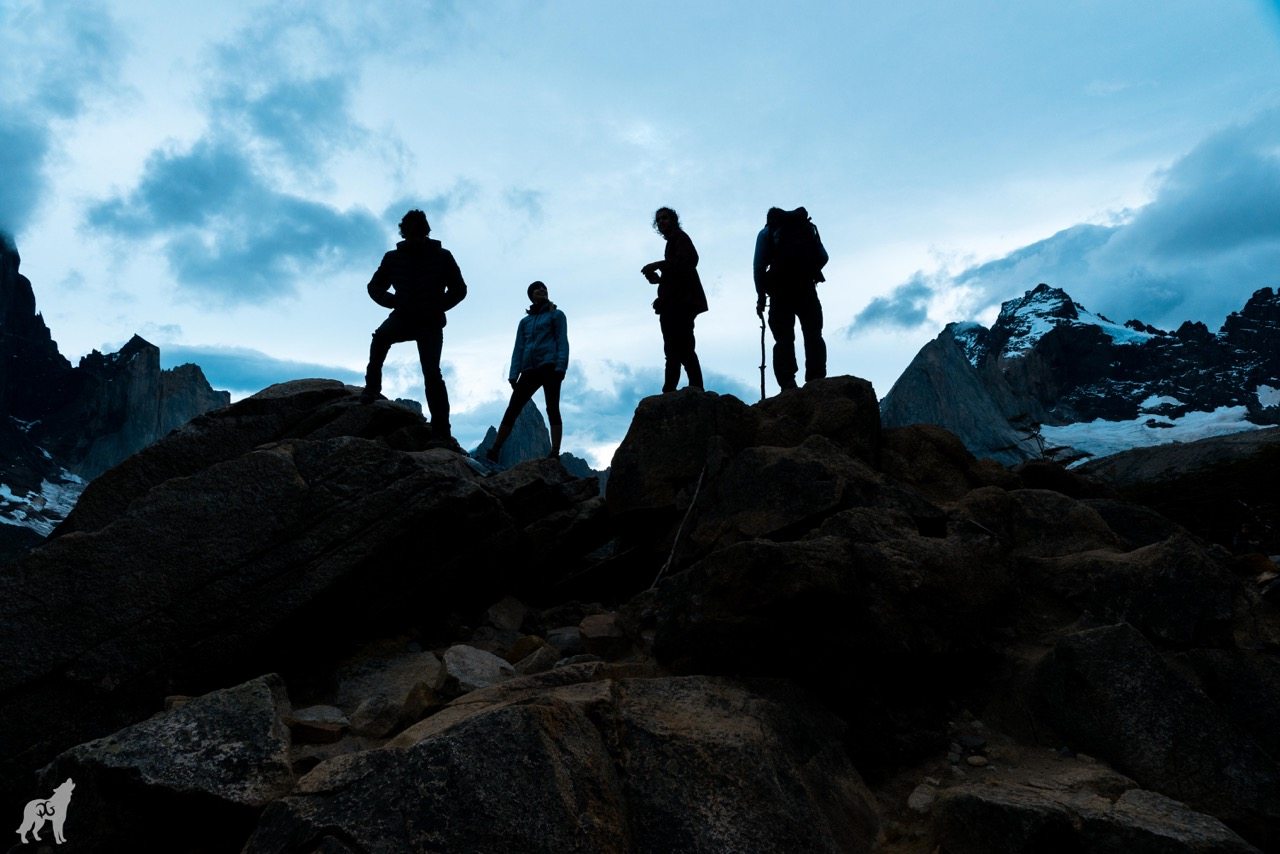
No, I am not inventing some secret code – this is just what the trails are called and they are named for their letter-like shapes!
Basically, there are 3 Patagonia hiking routes in Torres del Paine: “W” (4-5 days), ”O” (9 days) and “Q” (10 days).
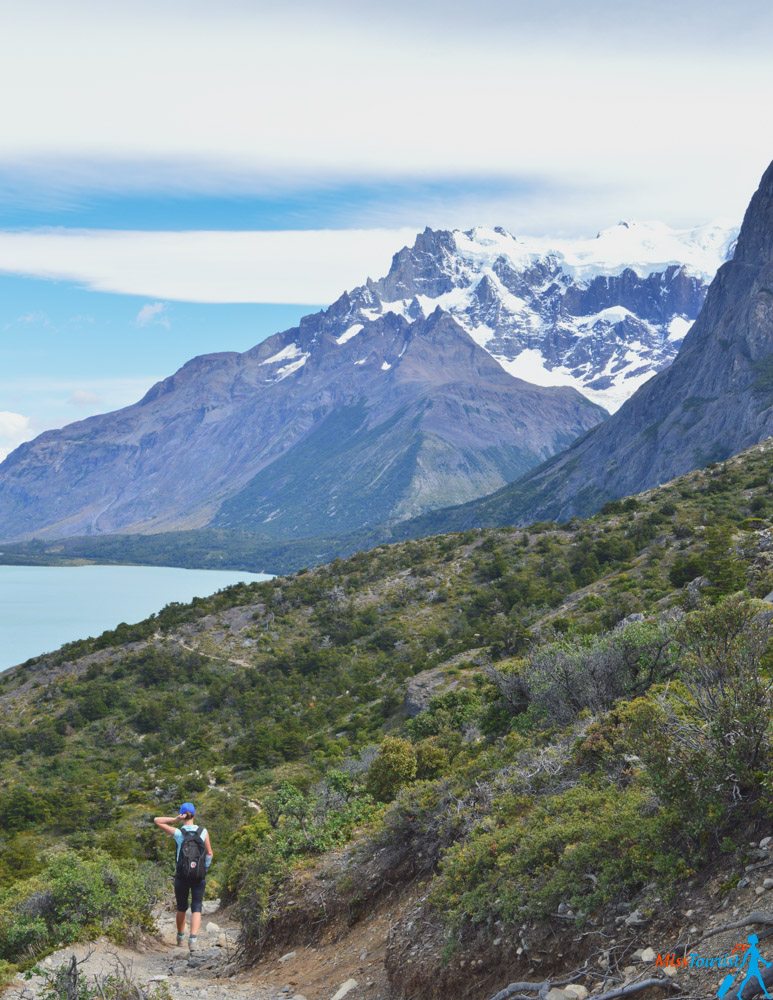
- The “W” trail is the most popular trek in the park and it was the option I chose, too. This trek will allow you to see the most important things including the Torres, which are the symbol of the park. Duration – 4 to 5 days.
Distance: 80 km / 50 miles
- The “O” (or the Torres del Paine Circuit trek) is a loop trail and it makes a circle around the entire park. I recommend taking this route in Torres del Paine if you have more time on hand and if you want to more deeply immerse yourself in nature. The “O” trail gets a lot less crowded after it breaks away from the W hike. Duration – 9 days.
Distance: more or less 110 km / 68 miles.
- The “Q” just adds an extra day to the “O”. You can take it if you still didn’t get enough of the beauty of the park. Duration – 10 days
Distance: 127.5 km / 78.8 miles
- If you are not feeling so adventurous, you can do an easy 1-day trek just to see the Torres and stay in a hotel close to it. Duration – 4-5 hours.
The W trek is basically part of the O and the O is part of the Q. Here is a picture of the Torres del Paine National Park map that I made so that it makes sense:
So, in which direction should you go – East to West or West to East?
So, in which direction should you go – east to west or west to east?
It truly does not matter. It really depends on the weather – plus, you will still need to come back. I did my W trek from east to west and it was perfectly fine. I chose east to west because I knew that the first day is the hardest, so I didn’t want to put it off until the end. But that was just my preference and you might want to do it differently, of course!
UPDATE: The O trek can only be hiked counterclockwise now. Hiking the W trail in Torres del Paine can still be done in any direction you prefer.
UPDATE 2: The “O” trek is closed between the 1st of April and the 30th of September for the 2019 season.
3. A tent or a hostel?
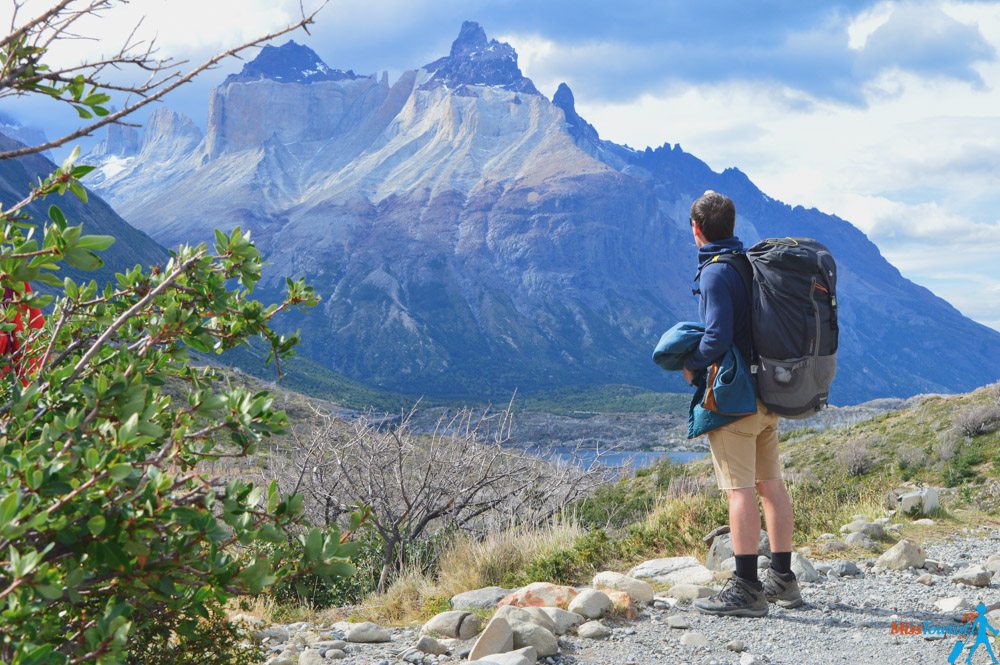
I guess you are wondering where to stay in Torres del Paine during those 4-10 days, right? Will you go for a budget option by staying in a tent or do you prefer the comfort of a room in a refugio (which is the name of the hostels in Torres del Paine)?
I chose a combination of camping and lodging because I wanted to have a good understanding of each of the accommodation alternatives so I could report back to you!
Oh, you are welcome, don’t even mention it! 🙂
Here are all the existing campsites in the park and their respective management company. Knowing this will help you plan your Torres del Paine itinerary easier:
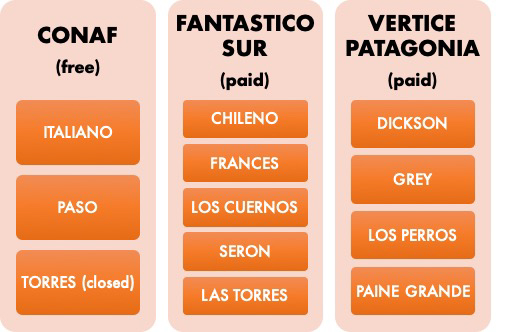
Let’s talk about both options below!
NOTE: Please note that you can’t do the trek if you don’t have your accommodation figured out beforehand. Because Torres del Paine has become such a popular destination, you can’t rely on finding a free camping spot or a room in a refugio on the spot anymore and you’re not even allowed to do so either. Please make sure to secure your accommodation for all the nights you will spend in the national park, as this is mandatory for the W and the O. If there are no places left in some of the refugios or camping sites, you might need to change the dates of your hike. After you make all your bookings, make sure to print your confirmations and have them with you as proof, as well as your passport.
A) Tent in a paid camping site
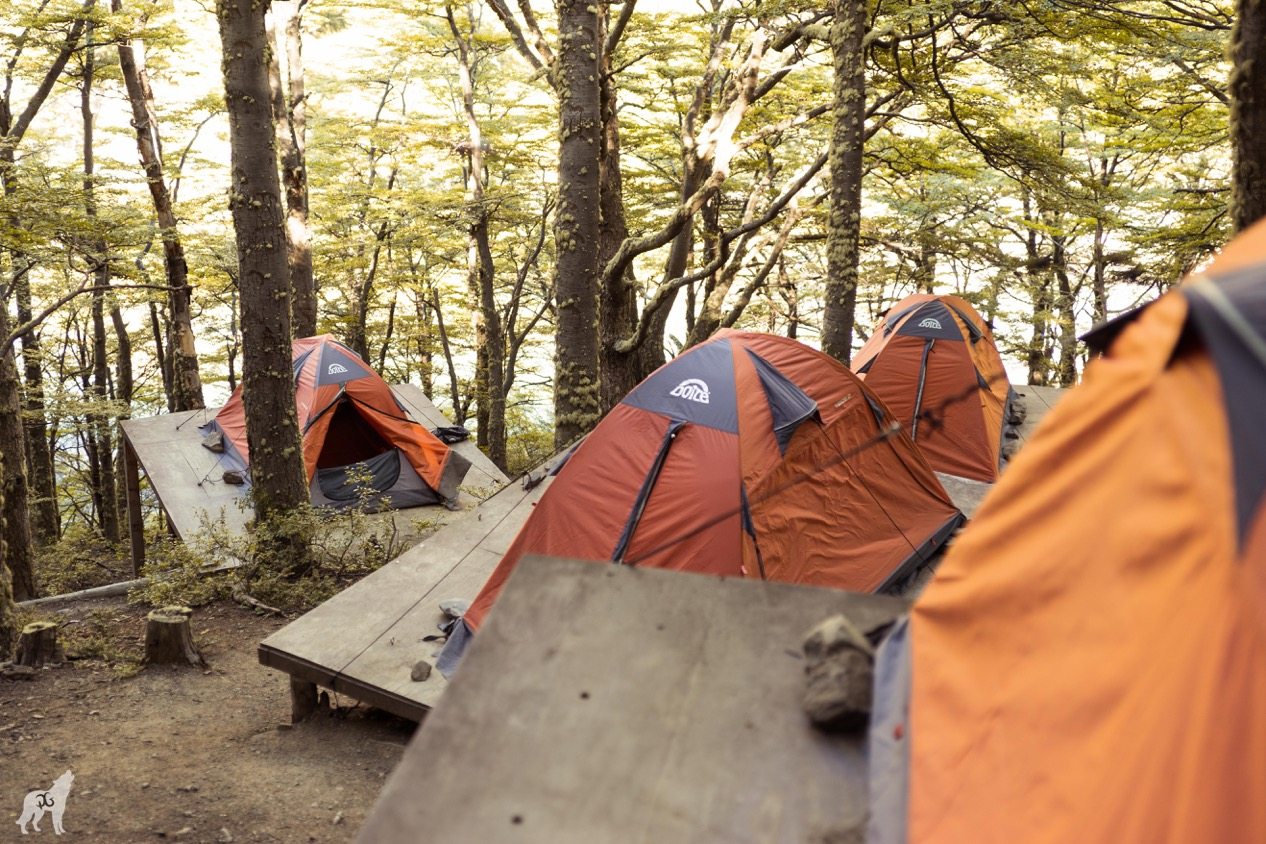
Even if saving money might not be your main reason for camping in Torres del Paine (yes, it is really romantic to spend the night in the middle of nature – when it is not windy, of course!), it is definitely much cheaper than staying in a refugio.
All of the paid campsites on the W trek are generally located near the refugios, which means that you will be able to enjoy all the facilities provided there – showers with hot water, kitchen, toilets etc.
Here is a link with the official map of Torres del Paine National Park with all the campsites marked. Below you can find two tables with all the available facilities for the paid camping sites:
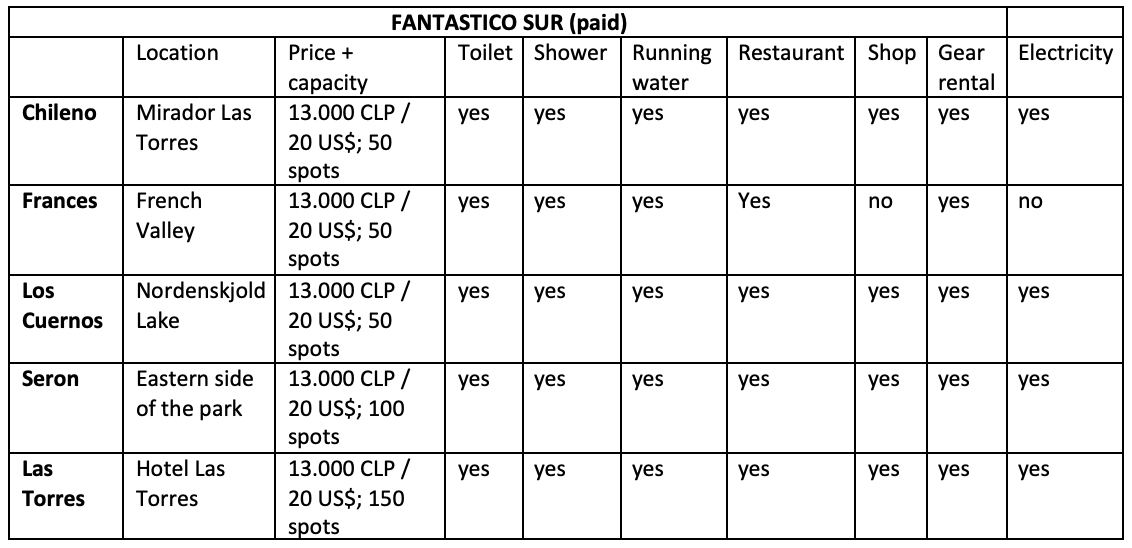
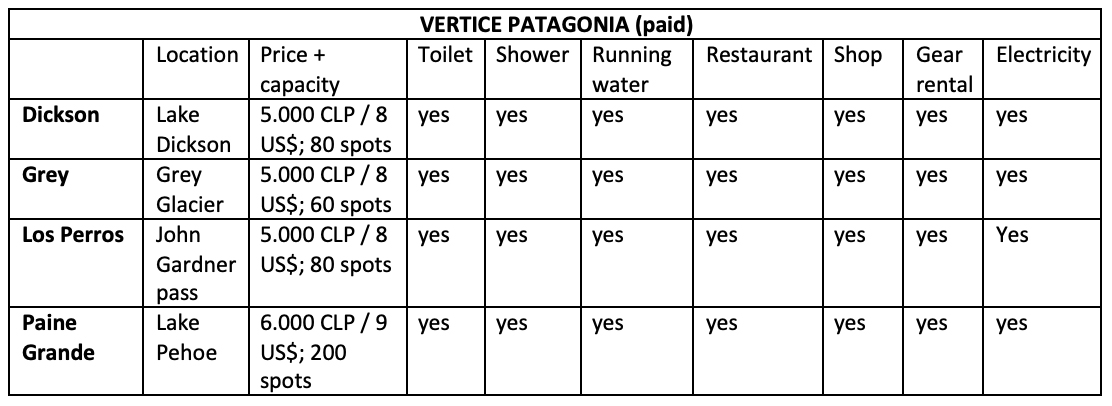
You can rent a tent from each individual refugio (+ sleeping bag and sleeping mat as an extra option if you want to). That is a cool option because you will not need to carry your own tent from place to place. You can rent one in one campsite, then you rent another tent in the second campsite and so on, which is a comfortable choice! Of course, you will also need to rent a campsite spot for this.
NOTE: Just to be on the safe side, make sure to check the condition of your tent and sleeping bag/sleeping mat before paying for it.
Alternatively, you can carry your own tent and use it in each campsite, which means you will only need to pay a small fee for using the facilities of the campsite.
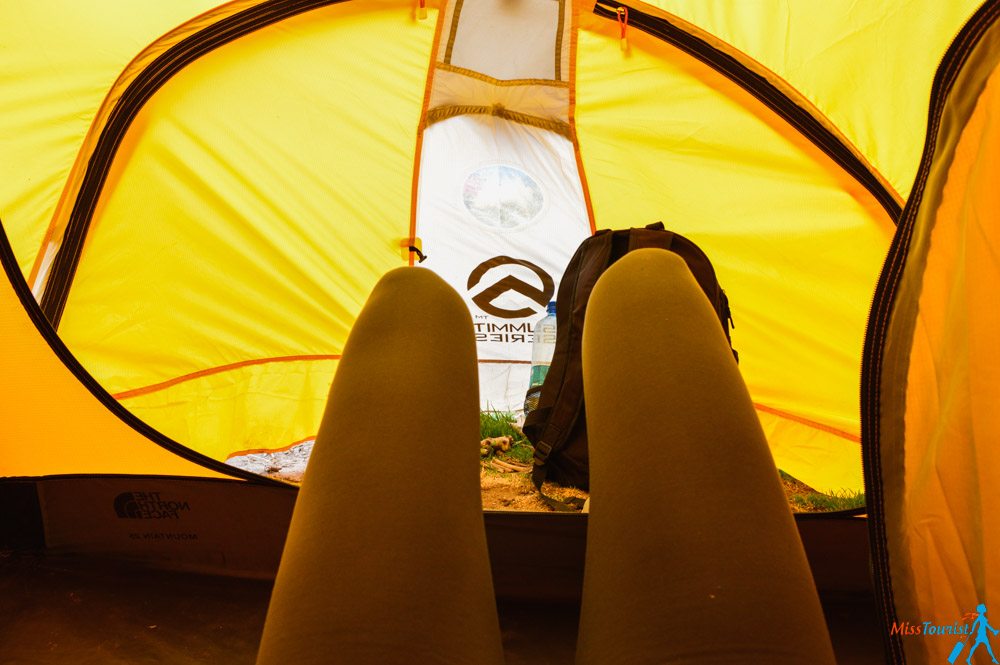
My experience – I am glad I could rent a tent in each camp (because there was no carrying involved), and I can say that it was a great experience overall. The tents are of very good quality and they are already set up for you! You will miss a bit of the camping experience but damn, I enjoyed having it ready! The facilities in the camping sites are good – hot water, basic kitchen (but you need to use your own stove which you can only use in designated areas at the campsite).
I also saw many people trekking Torres del Paine with their own tents. So, if the weight is not an issue for you, I think you will have a fabulous experience!
Booking the tent and/or camping spot for the paid campsites can be done using the Fantastico Sur wwebsite (Las Torres refugio and camp, Chileno refugio and camp, Camp Seron, El Frances, refugio Cuernos) and the Vertice Patagonia website (refugio Dickson, Camp Los Perros, Refugio Grey, Refugio Paine Grande).
Here are 2 pointers to make it a bit clearer for you:
- If you want to rent a tent for most of the W trek camping sites, you should book the place here.
- For the Paine Grande campsite and other camping sites on the Torres del Paine O trek, you can book here.
If you want to rent the whole package (which includes a tent, camping space and a sleeping bag) it will come to about US $50-$60 for 2 people per day. They have tents for 3 and 4 people as well. You can check the up-to-date prices here.
Price: About US $15 per person if you come with your own tent, and US $50-$60 for 2 people if you rent a tent with all the supplements (sleeping bag, mat).
NOTE: Please note that you can only camp in specially designated camping sites and that “wild” camping is strictly prohibited in Torres del Paine.
B) Tent in a free camping site
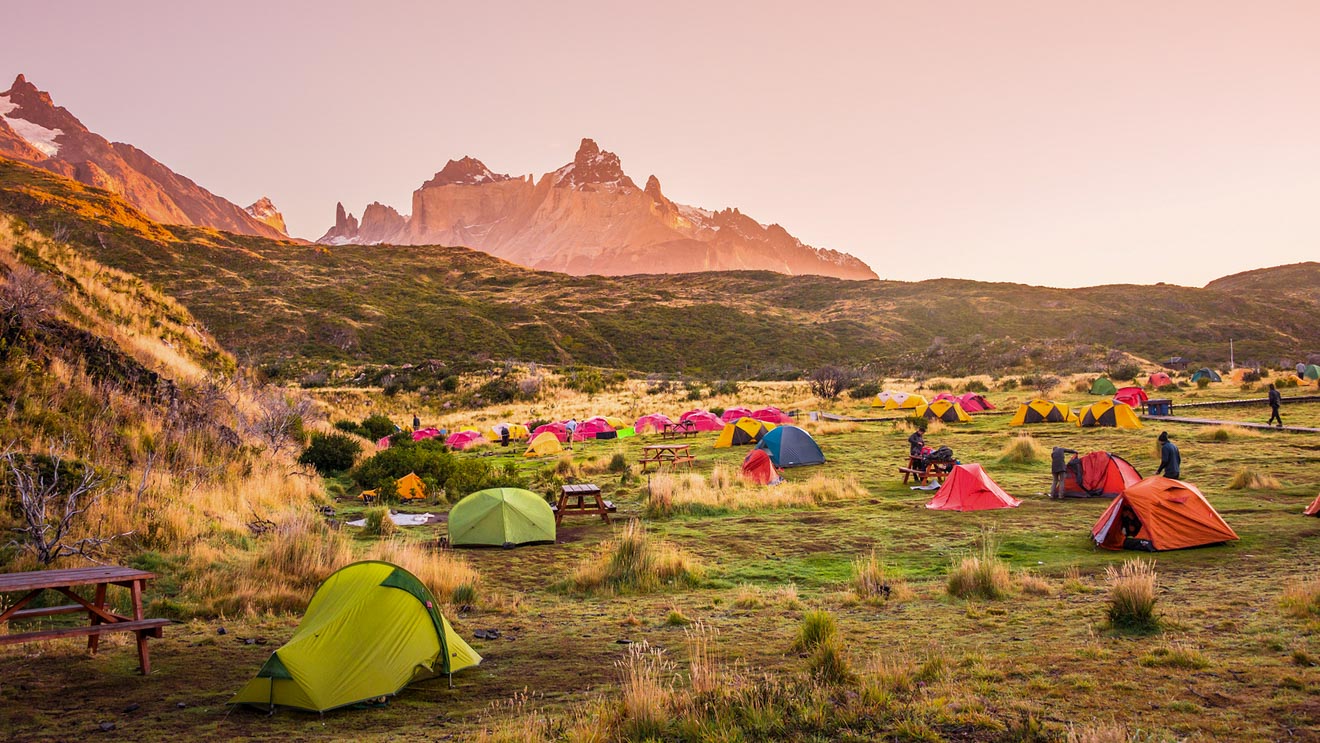
The free camping sites are owned by the park authority. They are harder to reach (which means you’ll be more tired at the end of the day), but they are placed deeper on the trek, which means they provide you with a more genuine experience. Note that the camps lack many of the facilities of the paid campsites, but for sure they don’t lack the good spirits, great atmosphere, and nice people!
Here is the table with all the available facilities in the free camping sites in Torres del Paine (without Camp Torres, which is closed for 2018-2019 season):

Booking a place in a free camping site should be done in advance, in order to secure your spot, because you will reach it tired at the end of the day. The procedure for booking was not as simple in the past when I first wrote this article, as there was no online booking for free camping sites, but it got easier! Now you can book your place in the free camping sites run by CONAF (Italiano, Paso and Torres camps) in advance.
Unfortunately, the procedure is a little bit tedious and their website is only in Spanish, but no worries, I am here to help!
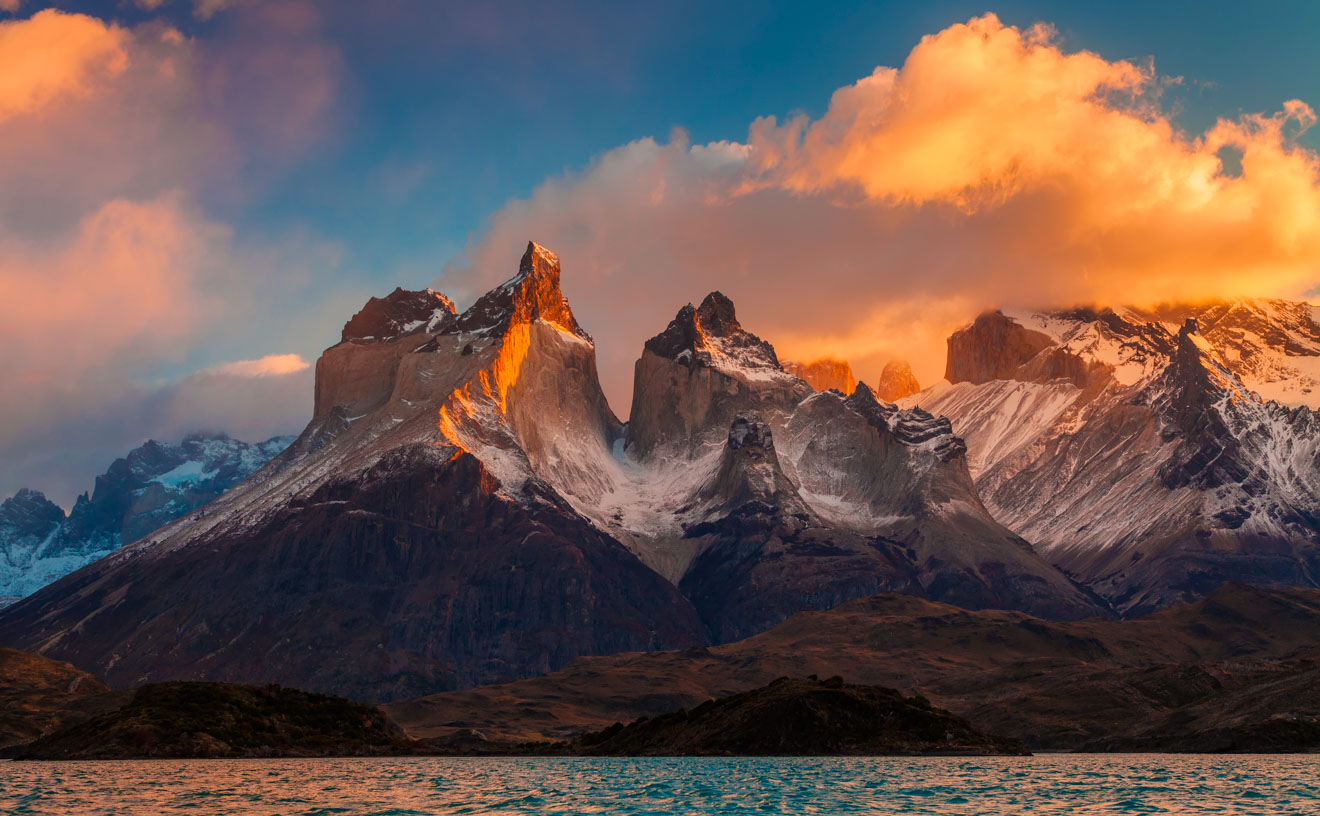
Here is how you can book on CONAF:
- Go on the CONAF website here.
- Create an account (select the pasaporte option) and log in.
- Click on “Inicio” -> select “Comprar” from the drop-down menu
- Fill in your personal details
- Click on “Selecionar Servicios”
- Select your dates for each campsite. If you notice some campsite are not there, go back to #3 on this list, click “Inicio” and then click “Ver Disponibilidad”. This way you can check the availability of the campsites for your desired dates.
Alternatively, you can Google Translate the website by right clicking in your browser -> Translate to English.
PRO TIP: Make sure to print out your booking reservations! You will be asked for proof of reservations by the rangers, as they don’t have a list for the free camping sites. If you don’t have it printed out beforehand, you won’t have any proof with you!
UPDATE: Camp Torres is closed for the entire 2018/2019 season.
UPDATE 2: Although the CONAF camps are still free of charge, when booking online using their website you will have to pay the entrance fee to the park (US $32 / 21,000 CLP).
C) Hotel (Hostel / Refugio)
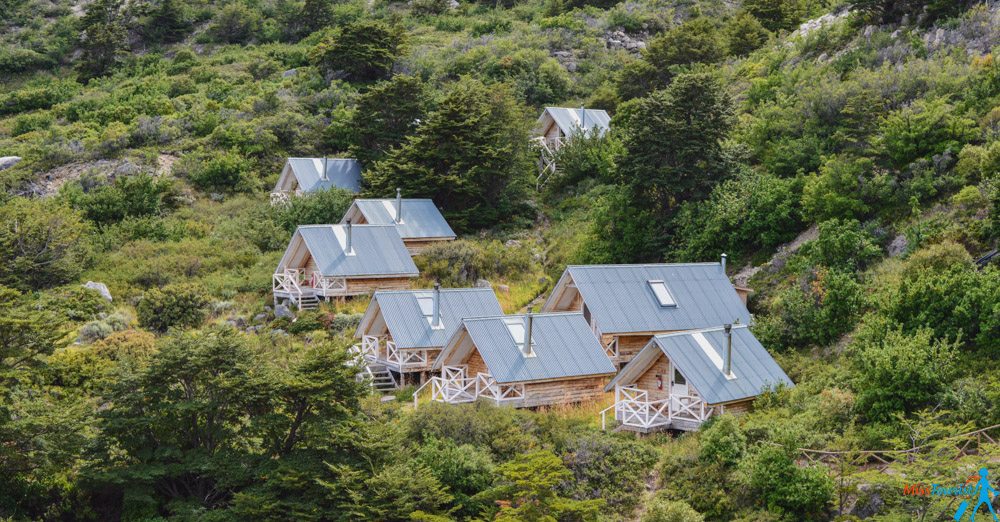
Hotels or, in most of the cases, hostels, are owned by 2 private companies in the Torres del Paine park – Fantastico Sur (on the eastern part of the park) and Vertice Patagonia (everything on the western side of the park).
I stayed in different refugios (hostels) for 3 nights and I can absolutely recommend this option. In some areas there are also cabins with hot tubs, so sometimes this could be an option, too.
Yes, it is quite pricey, but the territory of the refugios is located so far away, they need to deliver employees and food by helicopter to some of these areas. Even if the facilities are basic, everything is very nice and clean – I loved staying in Fantastico Sur refugios! And the fact that I was staying with another traveler in the room allowed me to make some awesome new friends on the road. I also took the full board option and I can say that the food was delicious and plentiful!
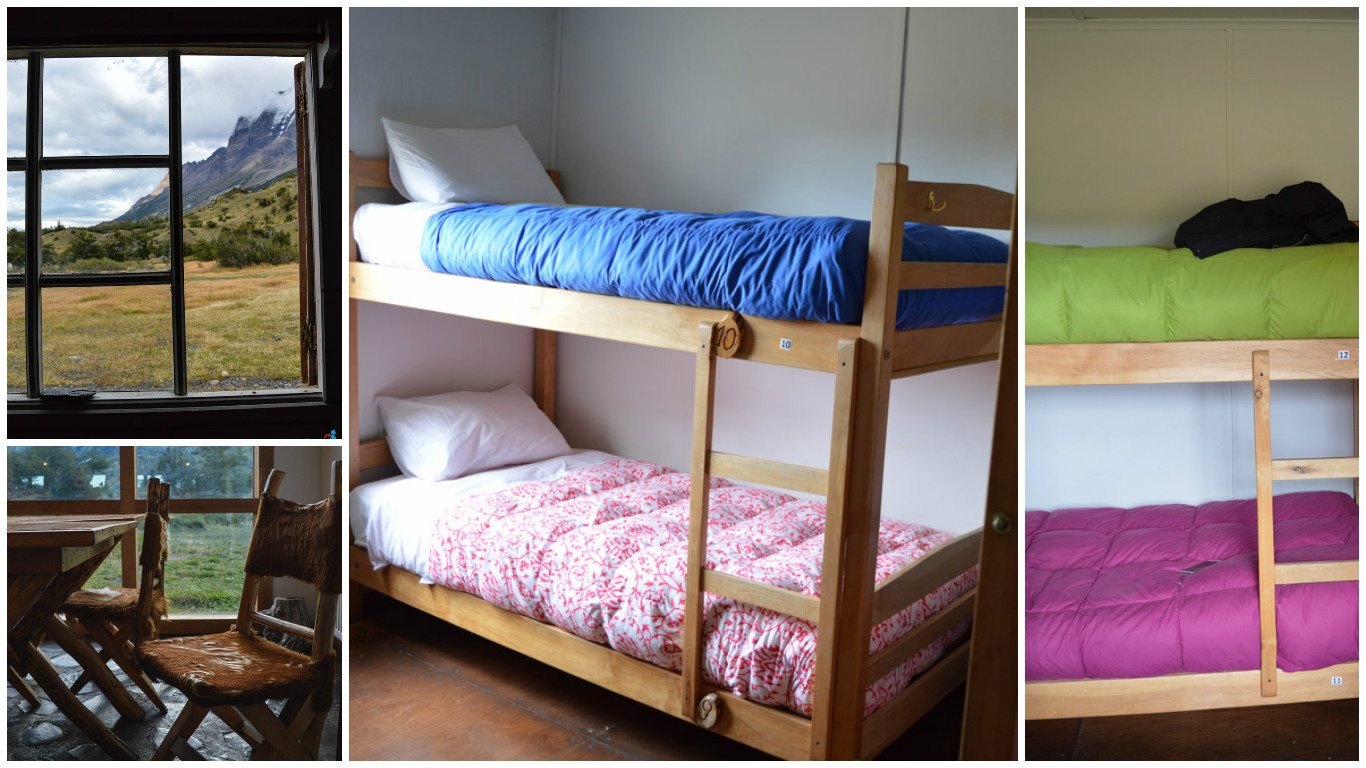
Please see the next section for food pictures.
Note: Refugios are not built everywhere. If you are taking an “O” trail, there are parts where camping is the only option.
Booking the refugios – Please book in advance. Refugios are sold out very fast, especially during the high Patagonia trekking season (December, January, February). You can book them here and here (depending on which camp you want to stay in).
Price: It really depends on the particular refugio you would like to stay in. The average price is US $80 per night per person. Again, it also depends on the season and the location.
The price is about 10% lower if you go off season. You can see the updated rates here.
Subscribe here to get up to 35% off your accommodation for your next trip!
4. Cooking or full board?
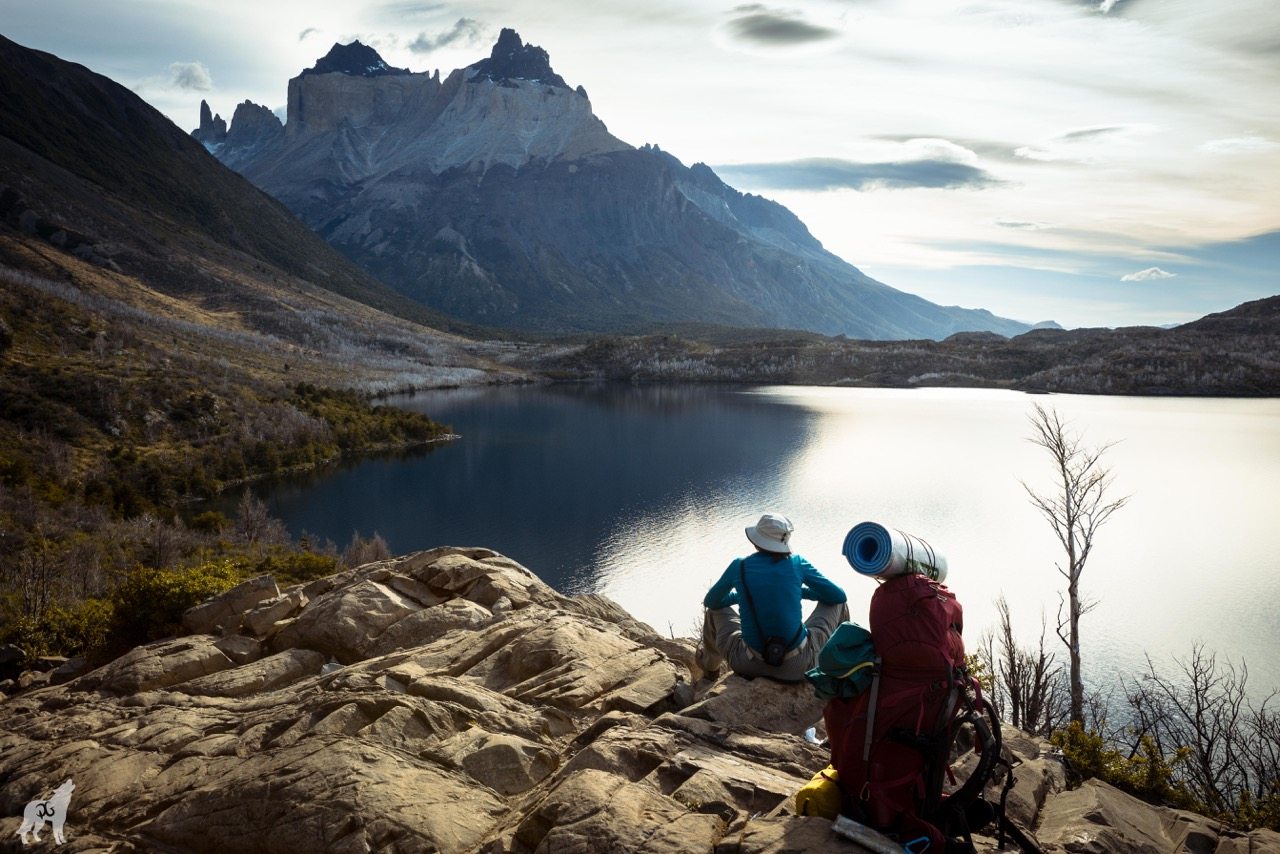
As you will be in Torres del Paine for some days and you probably want to eat something more than just chocolate bars, you should think about it and plan for it in advance! Are you going to cook your own food or will you use the full board option provided by the refugio?
Cooking the food yourself requires, of course, some preparation and most importantly, carrying everything in your backpack. But hey, it is much cheaper!
Packing food list in case you want to cook:
- can opener;
- for breakfast – one serving of oatmeal per person;
- for lunch – snacks such as carrots, chocolate bars, cookies, apples, or granola bars;
- for dinner – pasta dish, tuna, or rice dish for dinner (be sure to mix in some sort of protein);
- gas oven,
- water filter (not mandatory, but quite useful)
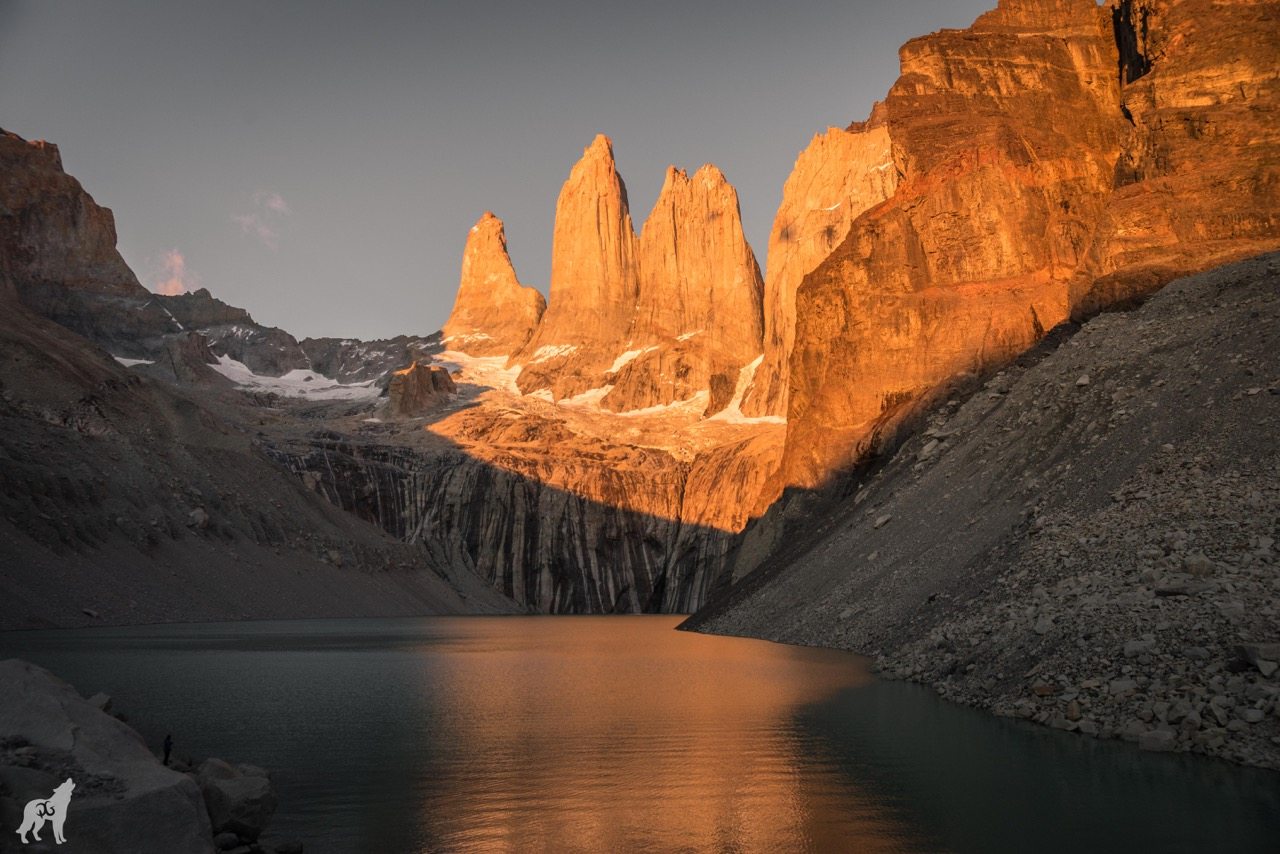
PRO TIP: A friend of mine hung her food in order to keep it away from mice and other rodents, but it was taken by a condor(!) during the night, so try to find a good place to store your food overnight!
Full board provided by refugios means you will eat breakfast, lunch and dinner cooked by the refugio, so you won’t have to worry about cooking and carrying all those cans of food. I am saying this over and over again because, believe me, the weight of your backpack will become super important after you walk with it for a few hours. Backpacking in Torres del Paine is no easy game!
Did you know that you can get the full board option (or order just dinner/lunch/breakfast individually) even if you don’t stay in the refugio? There were many people camping who came to the restaurant in the evening just to enjoy a nice warm dinner.
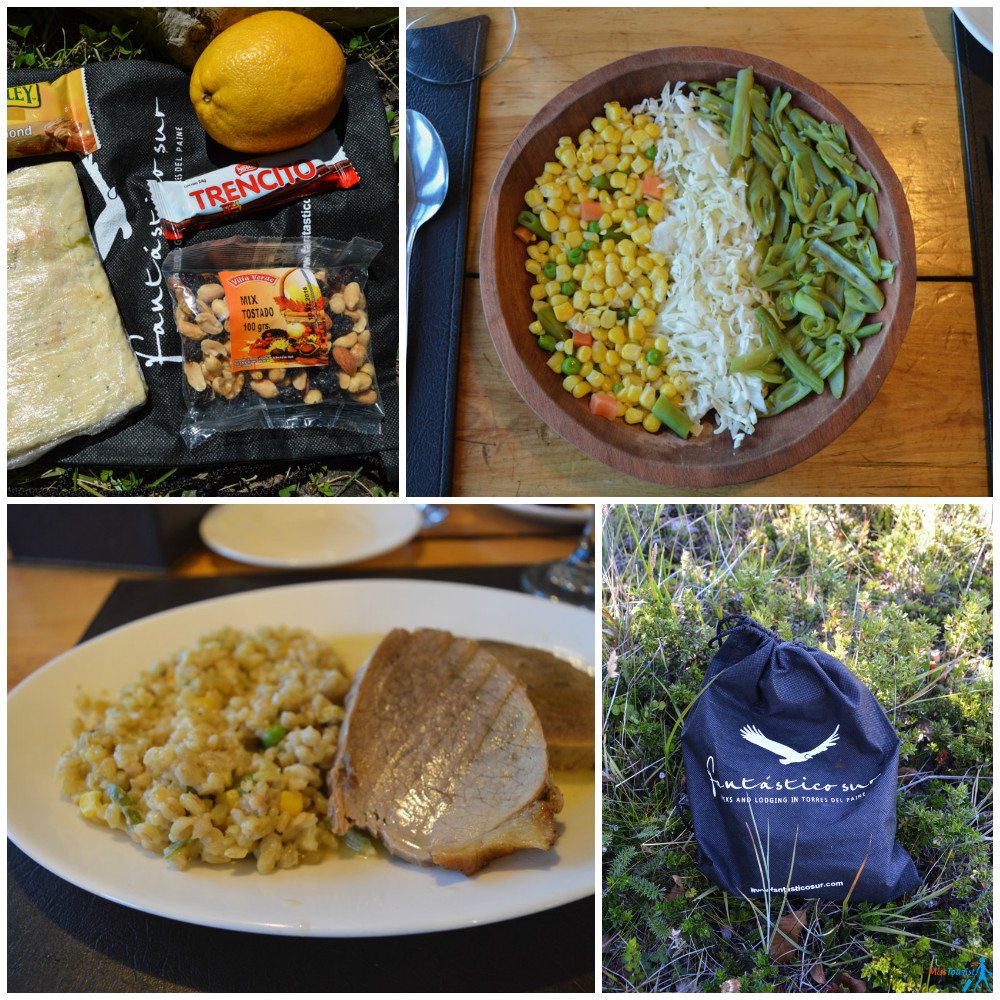
The dinner consists of 4 courses – a salad (appetizer), a soup, a main course (meat or a vegetarian option) and a dessert with tea. Wine is not included, but you can get it for quite an affordable price if you wish.
I remember both breakfasts and dinners being heavy (meaning a lot of food!), which was great because this is exactly what you need before or after a day full of activities. Lunch will be given to you in a lunch box. There is a vegetarian option as well.
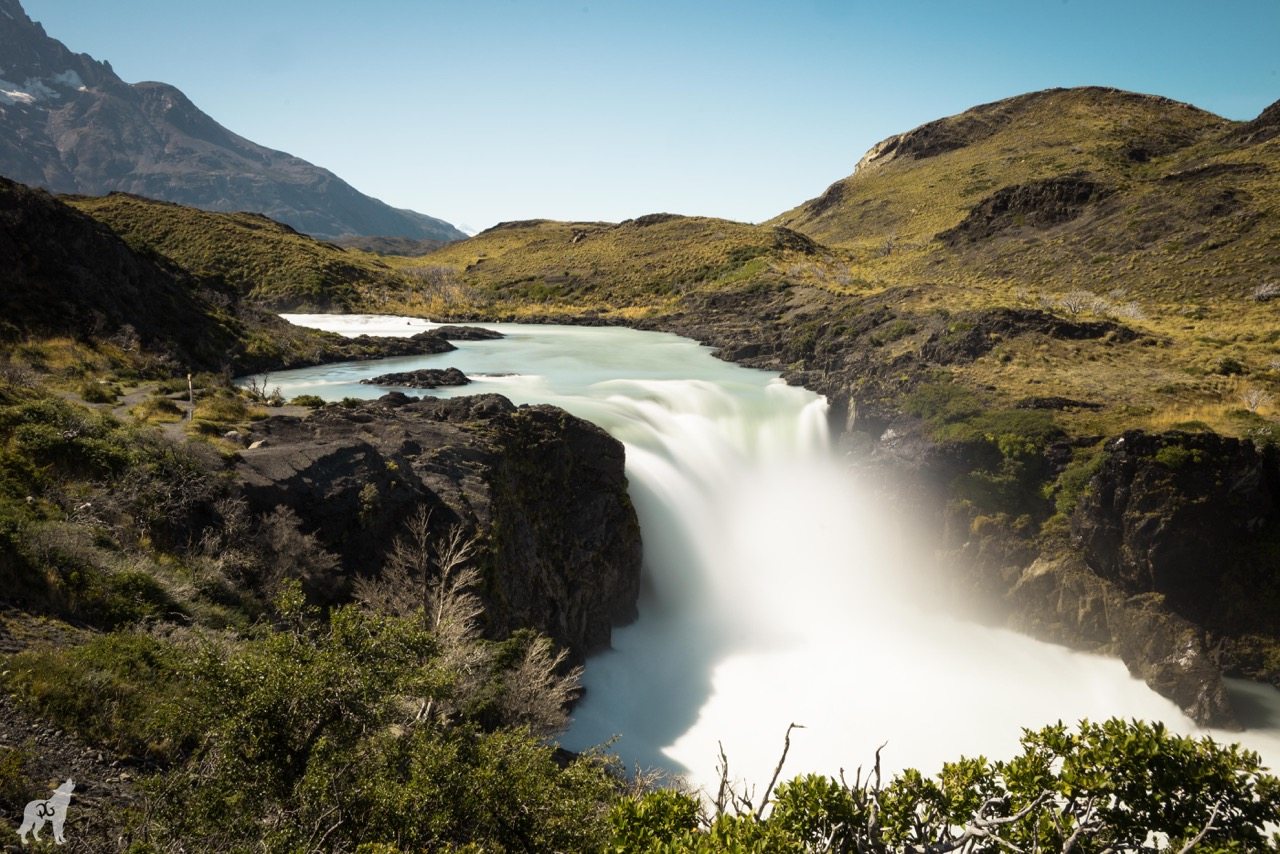
What about drinking water? Indeed, that’s a very important question. Thank God, you won’t have to bring liters and liters of water with you! Luckily, you are in a national park and the streams of water coming directly from the glacier are cleaner than any bottled water.
PRO TIP: Just one thing to keep in mind – the closer the running water is to the road, the more polluted it is. If you take the water directly from the river, there is a high possibility of other people or horses stepping in it. That brings dangerous bacteria that you don’t want in your body, so be careful. Just refill your bottles up the stream and you will be safe.
Some cabanas (another name for a refugio) sometimes add chlorine in the water, so try not to drink it! Just ask the people at the canteen to refill your bottle.
5. Light or heavy?
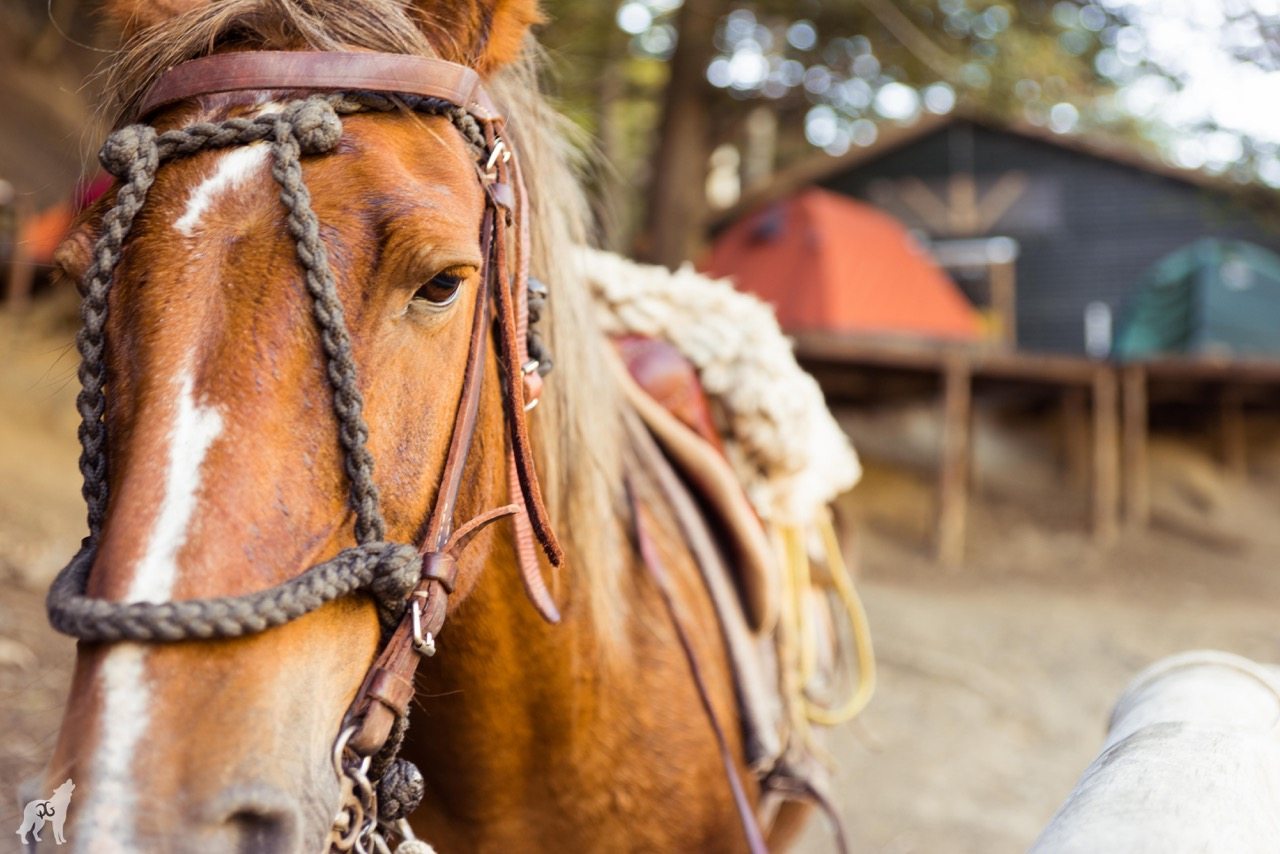
Oh, let me answer this question for you this time, can I? The only possible answer is “Light” here! 🙂
You should leave your main luggage in Puerto Natales. Each hotel/hostel there will watch your bags, as they are used to it. They have special storage for this and your bags will be safe there for the entire duration of your hike. I used a lock just in case, but everything was fine.
So, it is important to only take the stuff that you will REALLY need. A suggested packing list is below.
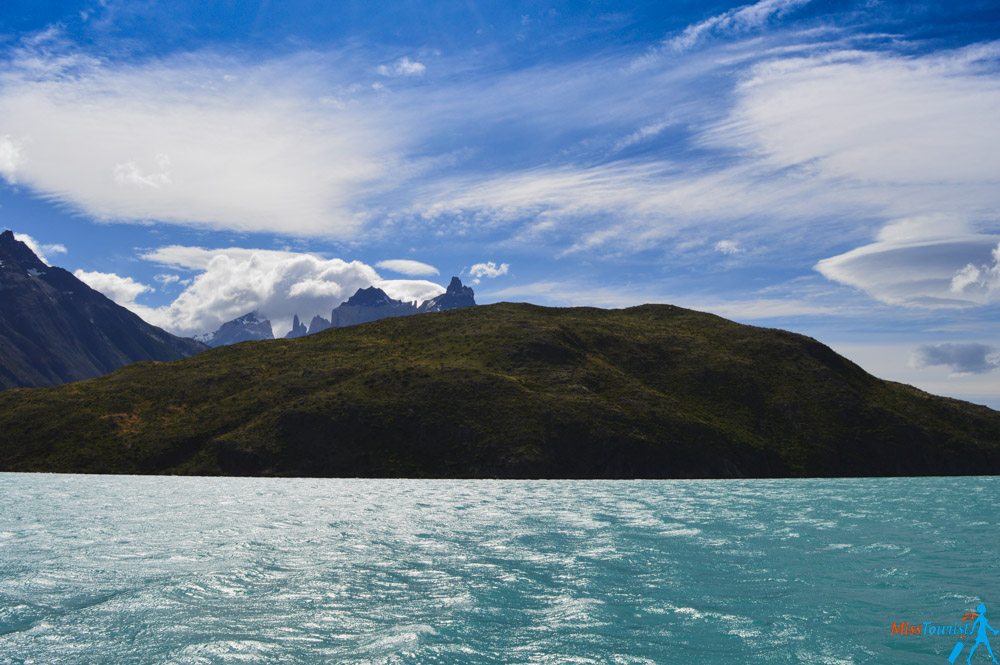
Packing list for Torres del Paine
- A waterproof backpack (duh!);
- T-shirts;
- GOOD waterproof hiking boots;
- Hiking pants;
- Walking sticks – highly recommended so you won’t kill your knees!
- A rain jacket;
- Your camera – don’t forget it!
- Food items if you are cooking (see the suggested list above);
- Sunscreen (min. SPF 30 – the radiation level is very high, try to always use it);
- Mosquito repellent (you might encounter a lot of mosquitoes in some places during your trek)
- Sunglasses;
- Toiletries;
- Flip flops;
- Socks(make sure to bring 1-2 pairs extra just in case)
- A towel;
- wet napkins.
- A basic first-aid kit
NOTE: As I mentioned earlier, the weather in Patagonia can be quite unpredictable, so make sure to pack both cold and hot weather clothes! As I always say: layering is your best friend!
There is also the possibility of hiring a porter, but if you ask me, that is not the point of being out in nature. Just bring the most important stuff with you and enjoy the park without any high-tech devices or dozens of dresses to wear in the evening. 😉
| 💵 Entry fees: | $35 up to 3 days |
| 🗻 Best tour: | 1-day tour |
| ☀️ Best time to go: | October to April |
| 📅 How many days: | 3-5 |
BONUS: Frequently Asked Questions about Torres del Paine
Here is everything you wanted to know about the national park. I have updated the posts from the questions you asked in the comments.
Here are the answers:
1. How do you get to Torres del Paine National Park from Puerto Natales?
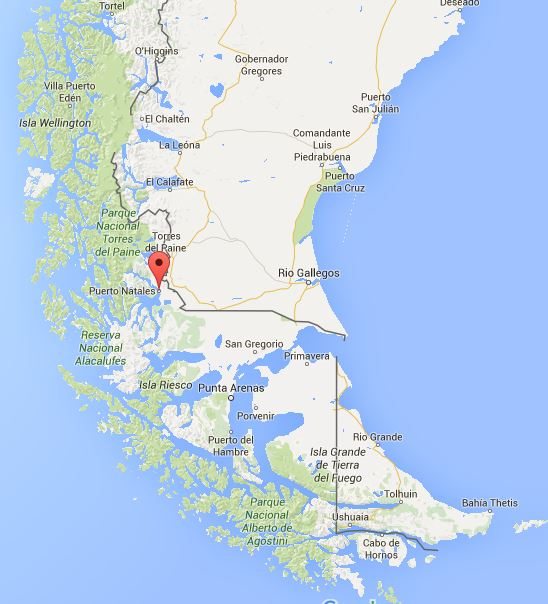
The closest city to Parque Nacional Torres del Paine is Puerto Natales. That is where I recommend you stay and have a rest for a day or 2 before the hike.
Getting to Torres del Paine is so easy, as there are plenty of buses from Puerto Natales to different entrances of the park that depart every day in the morning. You can buy your ticket from your hotel or just buy it from the bus terminal, whichever option works better for you. The ride takes around 2 hours and 30 mins and the price is US $23 / 15,000 CLP roundtrip.
NOTE: Make sure to keep your ticket as you will need it for the return ride.
2. How much is the entrance fee to the park?
For foreign adults, the entrance to the park costs around US $32 / 21,000 CLP during high season (1st of October to 30th of April) and US $17 / 11,000 CLP during low season (1st of May to 30th of September), regardless of the duration of your stay.
For foreign children it is US $8.60 / 6,000 CLP during high season and US $1.40 / 1,000 CLP during low season.
You can check the updated entrance fee here.
NOTE: The entrance fee can only be paid in Chilean pesos and they don’t accept credit cards or other currencies.
3. Is the Torres del Paine trek hard?
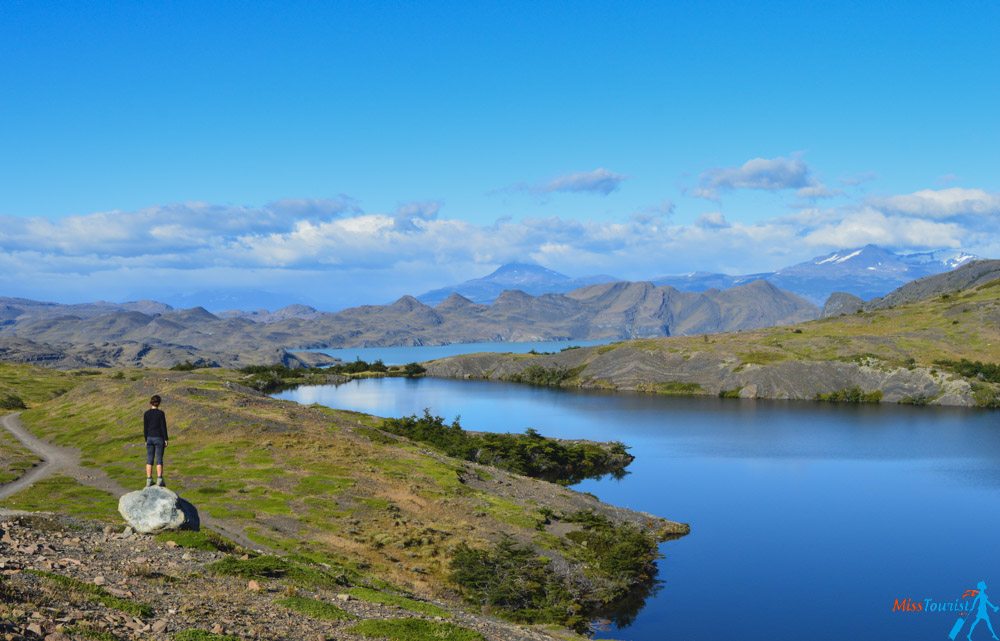
No, I would say it is relatively easy. If you compare it with Colca Canyon in Peru, or perhaps to the Inca Trail in Machu Picchu, it is much easier. There are no hills, just a bit of climbing and not even every day. However, if you are not in very good shape or the weather is windy, it can be quite challenging, but still doable for all ages and all levels. If you are doing the “O” or “Q” trails, I would suggest doing a long-distance hiking experience before as you will be carrying a loaded backpack for 8-10 days.
Occasionally, you will have to go up some steep steel ladders, climb across suspension bridges and go along deep mountain valleys. It is not easy, especially if you have heavy backpacks, but Torres del Paine has some of the most spectacular routes on the planet and it is so worth it! You will also meet many amazing like-minded people along the way!
Here is the Torres del Paine W trek distance and time estimate. It is pretty accurate – my total time was a bit faster maybe, but that is because I did not have a heavy backpack.
4. Is it easy to get lost in Torres del Paine?
No, in fact, if it’s very difficult to get lost! The paths are clearly marked and unless you really want to, you won’t get lost, no need to worry about that. 🙂
5. Can you do the trek alone or should you go with a tour?
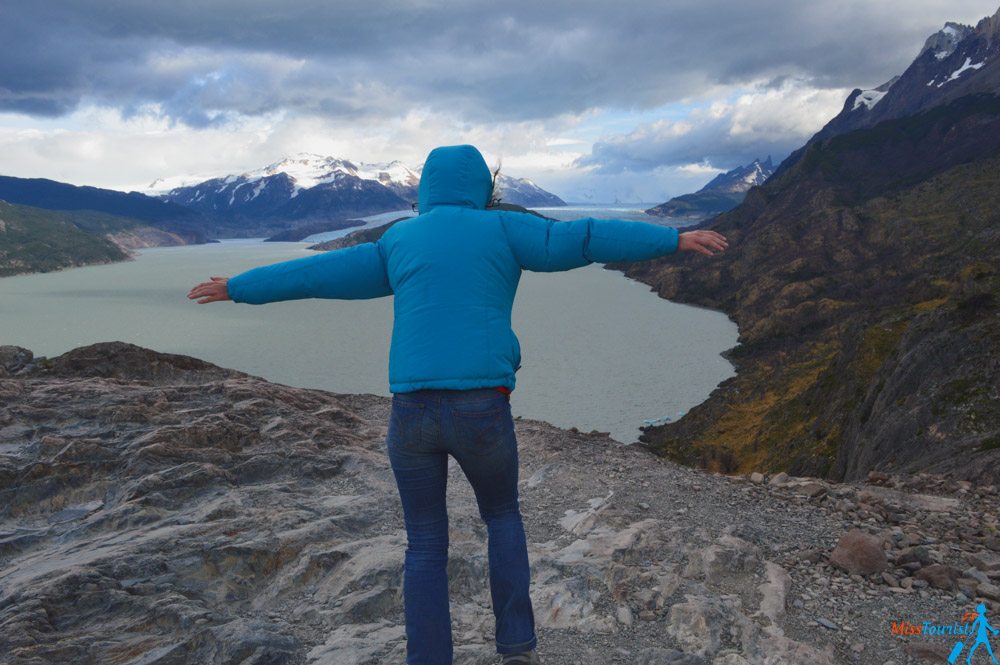
Many people wonder if you can do the trek by yourself or if it is mandatory to go with a tour. As usual, pick up your badge of courage and get on with it. Independent travel is absolutely possible, moreover, it even prevails in Torres del Paine! You can certainly go with a tour if you wish, but you don’t really need to. Every step of the way is well-marked and it is very easy to orient yourself, so you shouldn’t worry! Solo hiking in Torres del Paine is very popular and is definitely allowed.
Local guides say that the Torres del Paine treks are so easy and obvious that if you manage to get lost, they will put you on a wall of shame and make you famous!
Having said that, I understand that some of you prefer to go with a group – you won’t need to worry about booking anything along the way, the food will be taken care of and, last but not least, you will definitely meet many like-minded people during the tour.
Here are some good Torres del Paine tours I can recommend:
- If you are searching for some awesome Torres del Paine day hikes, this is a great 1-day tour during which you will hike the Ascencio Valley and you will see the Paine Towers, lagoons and the granite spires of Torres del Paine. Entrance fee to the park and food/drinks are not included.
- If you want a 5-day Torres del Paine trek for the W trail, this one is the perfect choice. It includes accommodations and food for the entire period, the entrance fee to the park, round-trip transfer from Puerto Natales, and the Pehoé Lake catamaran.
- If you want to do the Torres del Paine full circuit (the “O” trek), I suggest this 11 days tour that departs and ends in Puerto Natales.
6. What will you see in Torres del Paine, Chile?
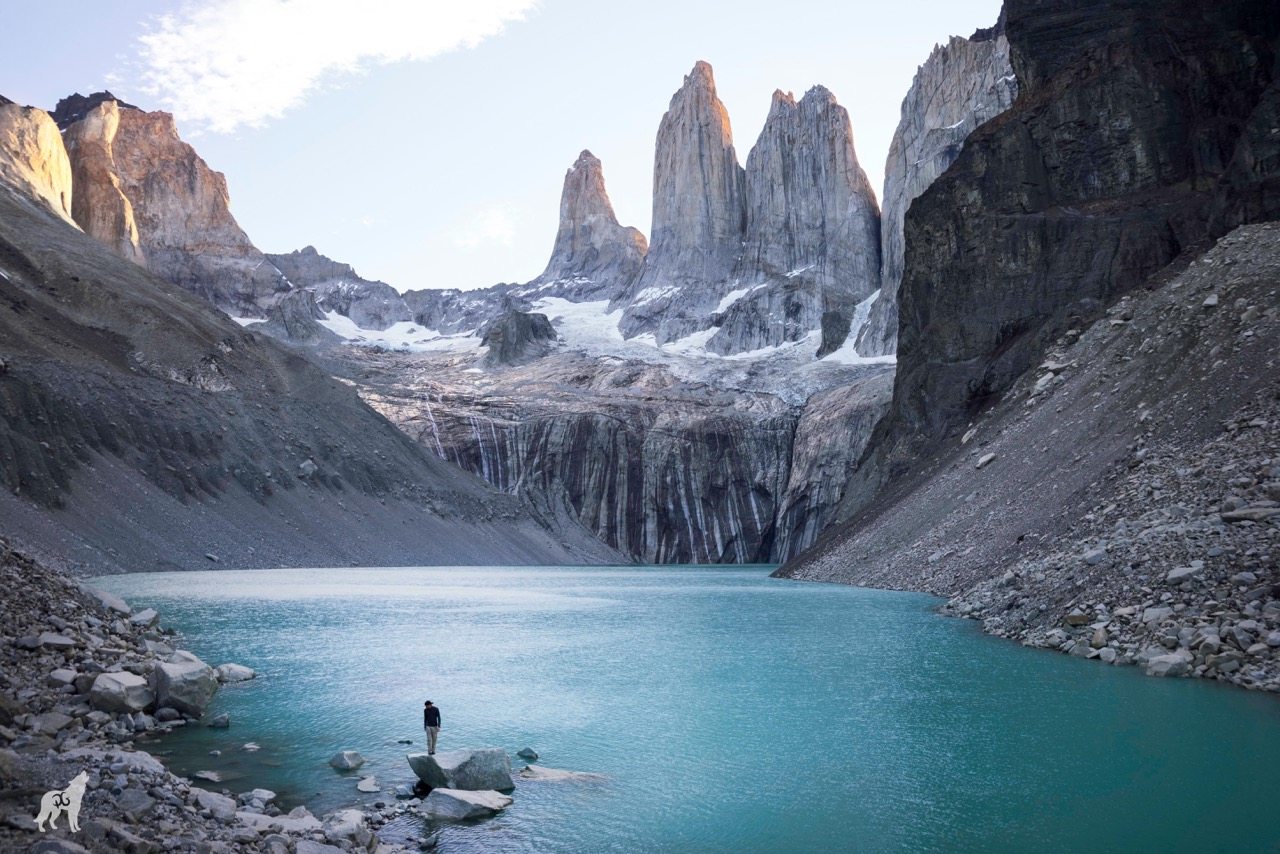
Visiting Torres del Paine is definitely an unforgettable experience and the incredible natural beauty of the national park left many people speechless! This is a place where the color of the crystal-clear sky is just indescribable, its nature is unique and you will have plenty of wildlife to discover around you.
Here are a few highlights:
The Torres – 3 huge granite towers called the “torres” (which means towers in Spanish) – these are the symbol of the National Park. If you want to see them at sunrise, you should stay at Campamento Torres (make sure to book in advance), as this is the closest place to get to the Torres. You will still have to do a hike of about 1.5 hours). I saw the torres during daylight, but it was stunning nevertheless!
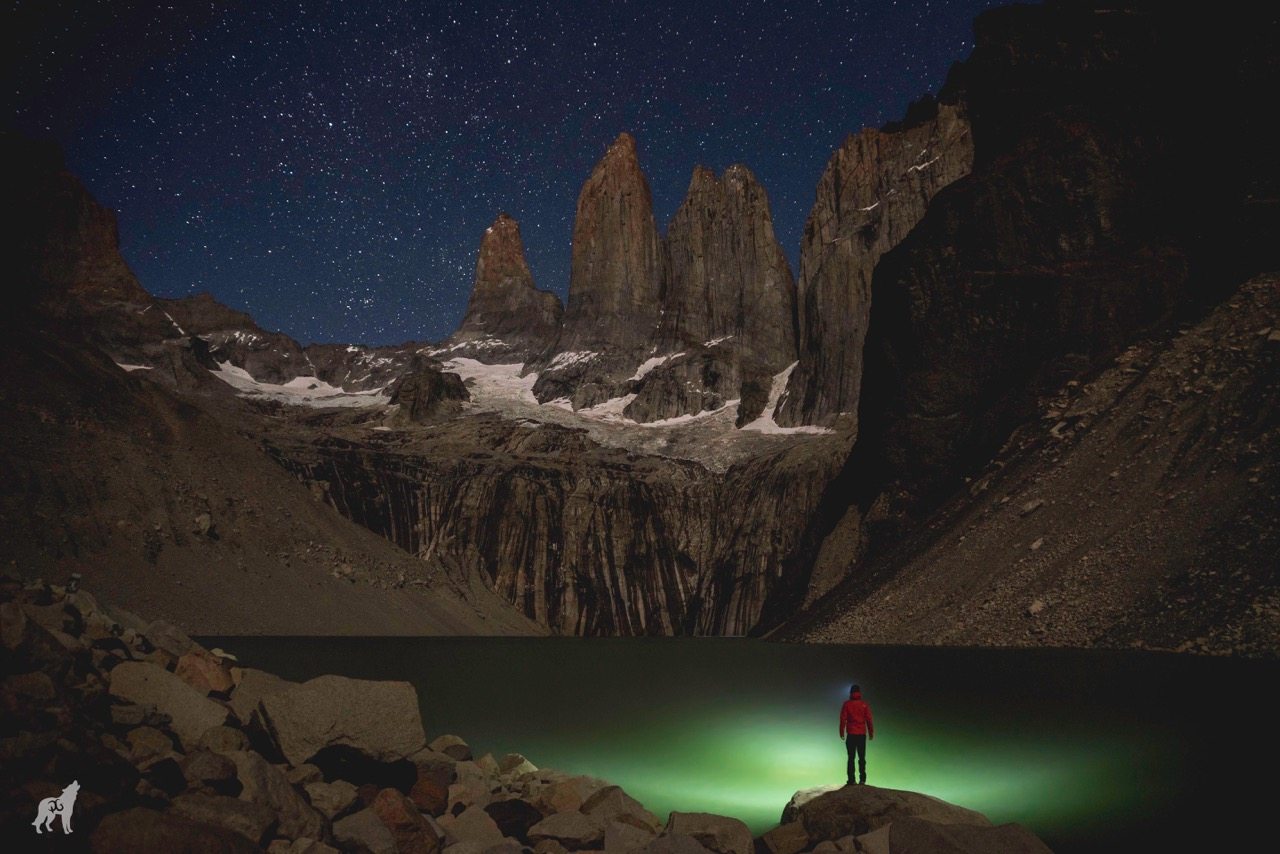
Grey Glacier that is fed by the Southern Patagonian Ice Field. Climbing up there and hearing thunderstorms from time to time (that are actually ice falls) is an unforgettable experience!
French Valley in Torres del Paine offers so many photo opportunities!
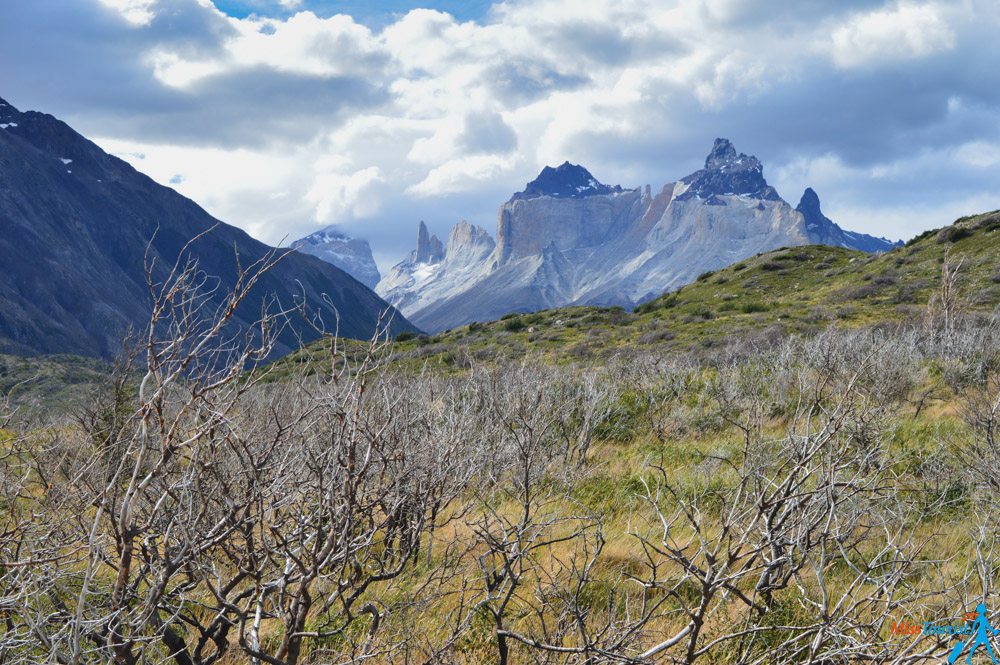
And many, many more views of incredible natural beauty!
7. So, how much is it again?
Yes, even if we already spoke about this a bit, there are too many variables in this equation. The final price of your adventure depends on what level of comfort you prefer, your budget and the season when you are going as well.
These are the fixed prices that you will have to pay for the Torres del Paine W trek:
- Roundtrip bus from Puerto Natales – Torres del Paine: 15,000 CLP / US $23
- Entrance and permits fee to the park during high season: 21,000 CLP / US $32
- Catamaran across Pehoé Lake: 18,000 CLP / US $28 one-way
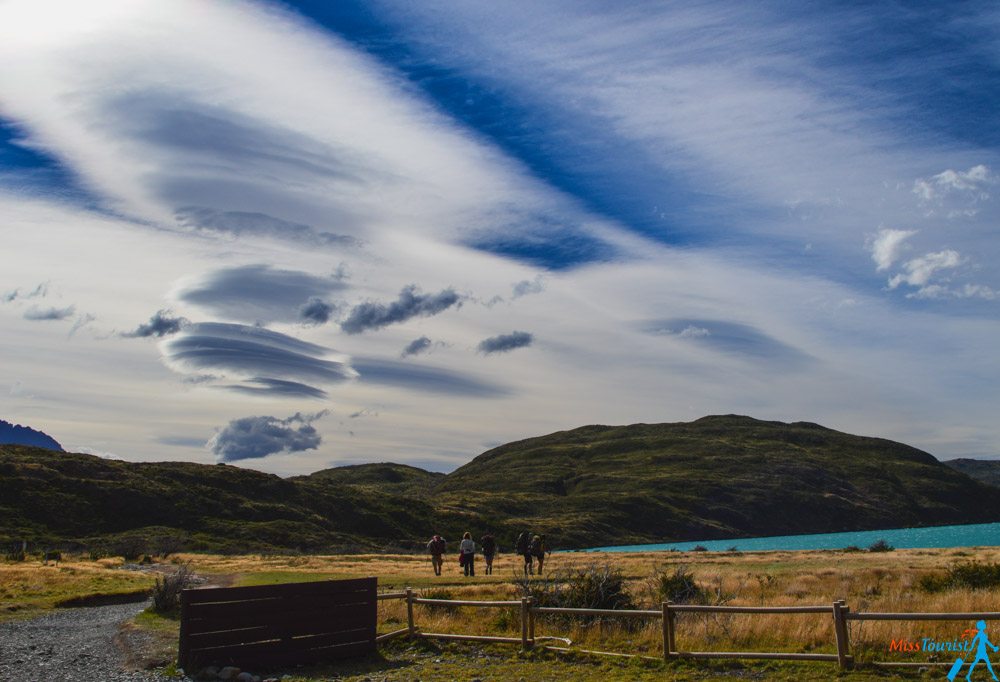
Let’s look at some lodging options. The total prices below are calculated without the entrance fee (US $32) and are based on the W trek which is 5 days long:
- Cheap – carrying your own tent, camping in free or cheap places (around US $10 /night for the paid campsites). Cooking, eating and carrying your own food (around US $10 /person/day).
Total: around US $80 /person without the transportation and entrance fee.
- Medium – Renting tents from the camp (around US $30 /person/night) and eating food provided by the cabanas from time to time (from US $17 to $24 /meal).
Total: around US $250 /person without the transportation and entrance fee.
- Expensive – staying in cabanas (around US $110 /person/night), eating the food provided by the cabana (from US $17 to $24 /meal).
Total: around US $850 /person without the transportation and entrance fee.
- Luxury – staying in a luxury hotel in Torres del Paine and having your luggage carried by horses. The problem is that your choice of hotels will be very limited and sometimes there are hardly any options. However, there is a luxury 5* hotel called Las Torres, which is located relatively close to the Torres. The hike from the hotel up to see the torres is about 4 hours.
Total: around US $450-$500 /double room/night for the normal package and around US $1,300 /double room/night for Hotel Las Torres all-inclusive package.
And yes, you read it correctly – even staying in a hostel in Torres del Paine can be quite pricey. The hostels are owned by private companies and it is hard for them to transfer all the goods there, which is why the price you pay for a hostel here can equal the price for a good hotel somewhere in Europe.
I personally combined the medium and expensive options – I stayed in cabanas for 3 nights and 1 night in a camp, renting a tent from them.
8. What are some important things to remember?
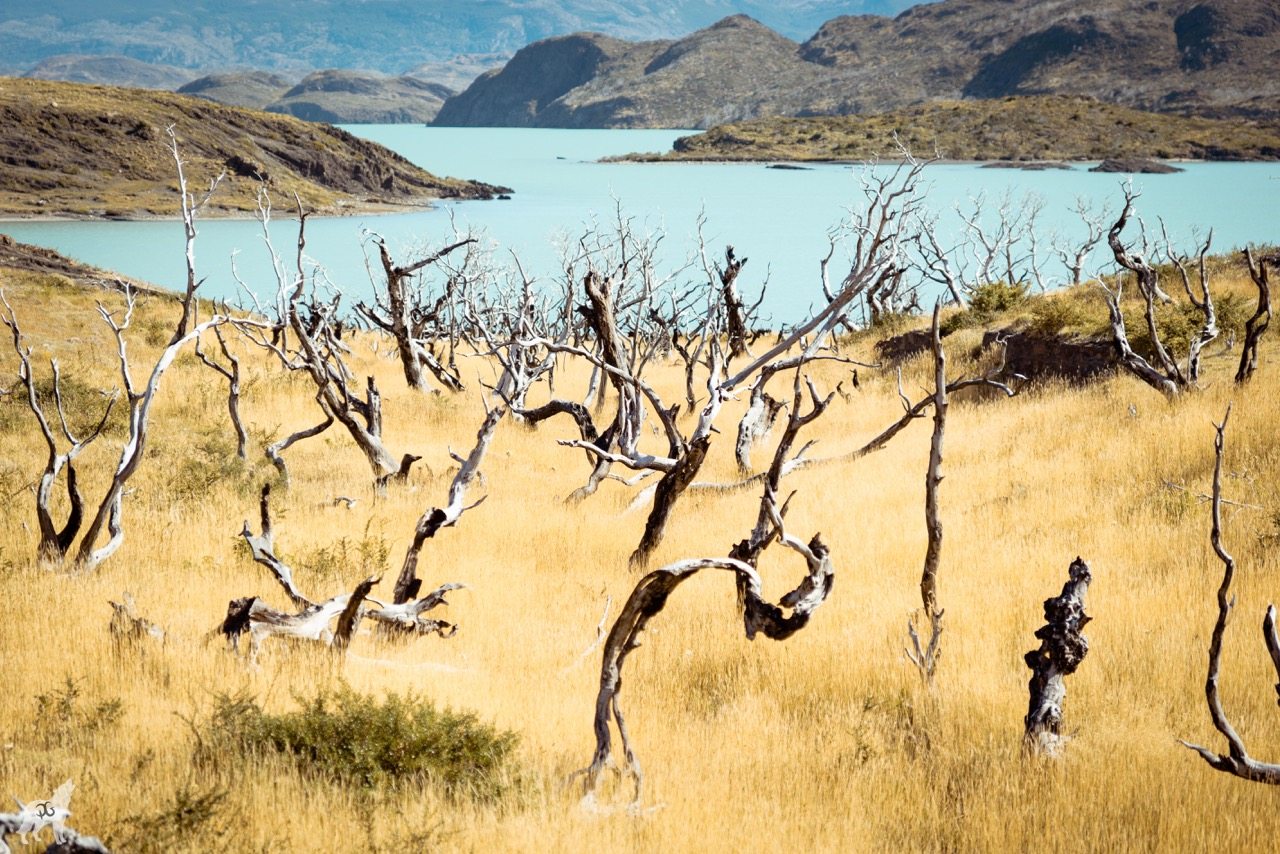
- Fire safety regulations – NEVER, and I really mean never, ever light a fire in Torres del Paine National Park! The fire will spread so fast and the trees are so dry that you won’t be able to stop it. This is a really serious issue. Some guys did it 4 years ago and they destroyed 40% of the park trees, had to pay a huge fine and they are now not allowed into not only the park but the entire country. Please don’t start any fire in the park.
- There will be no Internet unless you are willing to pay extra. Many refugios provide a “Wild-Fi” service, but I would advise you to connect with nature, isn’t that why you are there? There is no point in carrying your laptop whatsoever.
- Put your clothes in a plastic bag and then in the backpack – this way they won’t get wet if it rains.
- If you want to prepare even more, I recommend attending this Erratic Rock Torres del Paine seminar a day before. They hold it every day at 3 PM. It is free of charge and it gives you a lot of valuable info.
9. Can I charge my phone and other electrical equipment at the camp sites?
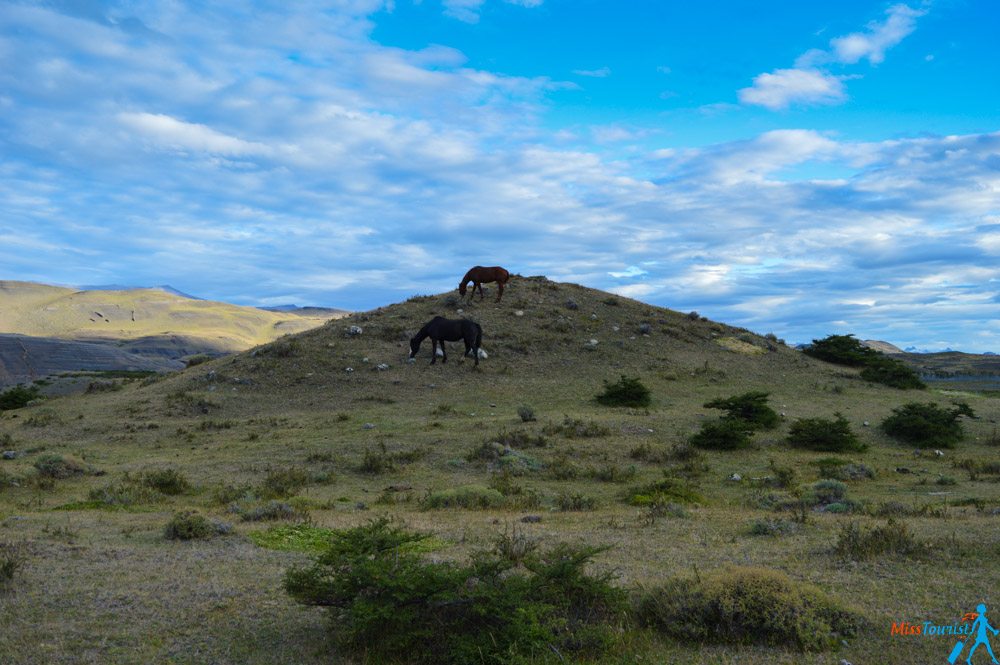
Yes, some Torres del Paine camping sites have charging points (for example Paine Grande, Los Perros, Los Cuernos). However, I wouldn’t rely on them and it is best to have an external battery with you in case you need it and charge your devices with the USB.
10. Can I buy things in the park if I forgot to pack something?
No. There are no shops or ATMs in the park, but there is a supermarket in Puerto Natales where you can buy food before your trip. Of course, you can also buy food at the refugios in Torres del Paine.
Conclusion
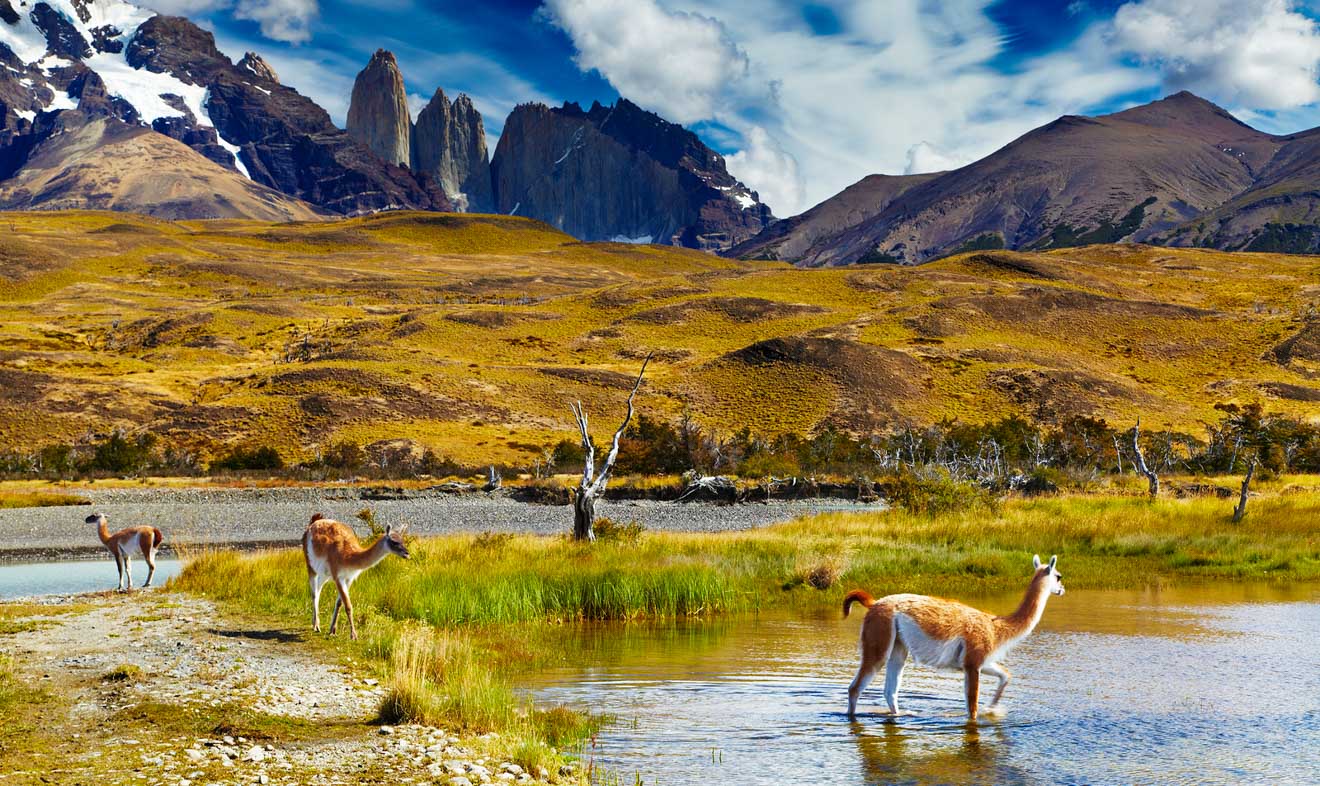
Here in this post I have included some important details about the Torres del Paine trek that I couldn’t find in other blog posts on the internet. The idea was to find all the info in one place – which trek to take, how much exactly it is going to cost you, how long it will take, what to take with you and many other little things that I noted down while doing the trail myself.
Even if it is not as cheap as the tour of the Salt Flats in Bolivia, for example, you will experience a totally different beauty and I recommend doing it!
P.S. While touring Torres del Paine, I met a talented photographer named Pehuen Grotti, who generously allowed me to use his fantastic pictures on my blog. Follow him on Instagram and Facebook for more!
Disclaimer: I was invited to Fantastico Sur as a guest, however, all opinions are, as always, my own.
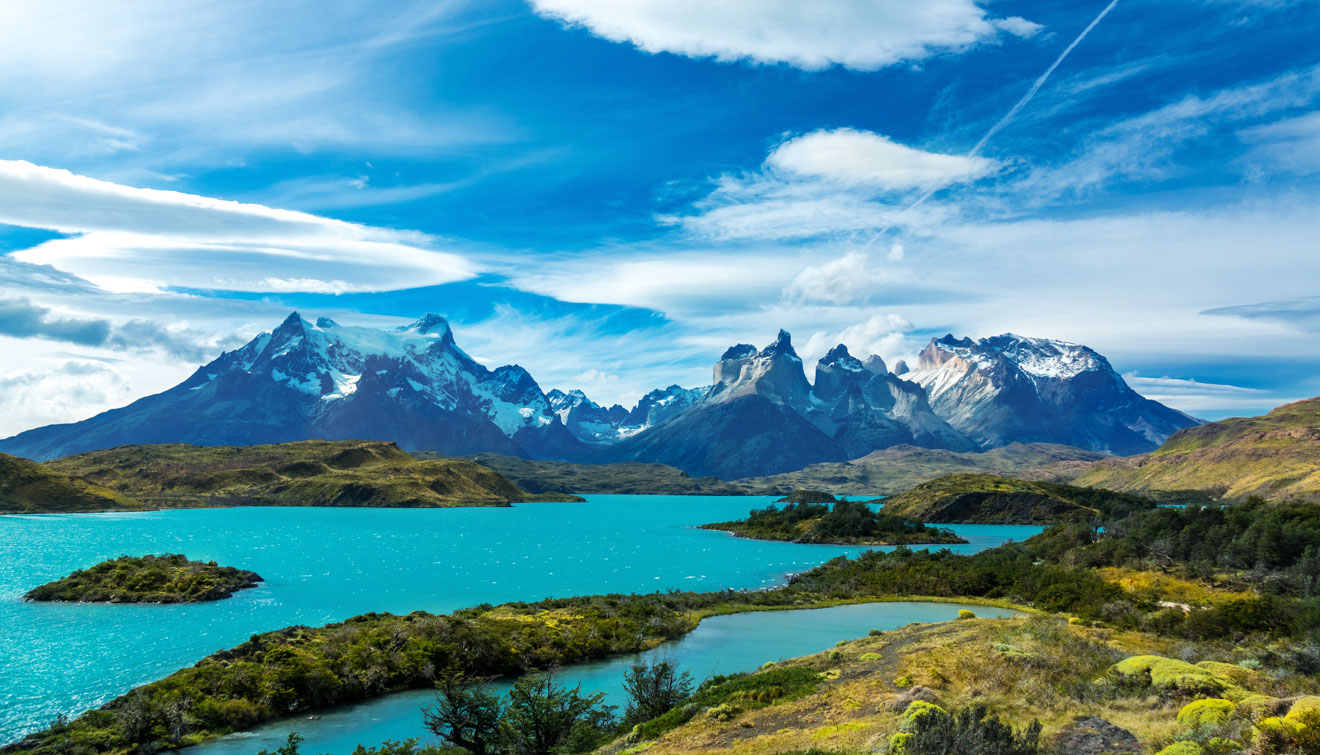
Have you already done the trek? Are you thinking about it? Share your thoughts in the comments!
Yulia
Have you already done the trek?
Are you thinking about it?
Share your thoughts in the comments!
And don’t forget to “Like” this post, make me smile! 🙂
Yulia
Pin it for later!
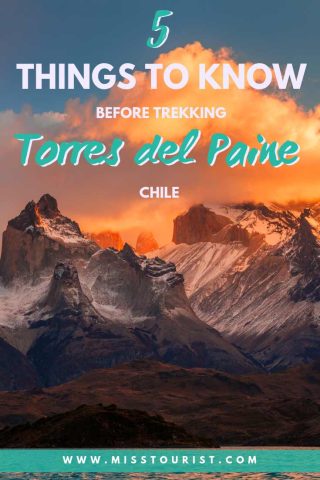
Pin it for later!
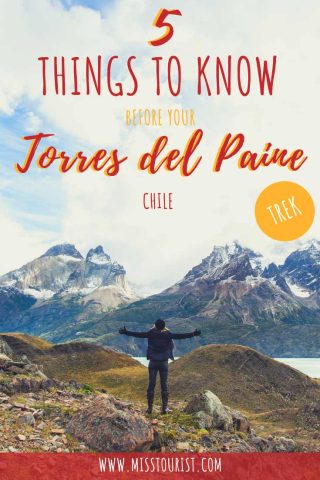

 Yulia Saf
Yulia Saf 




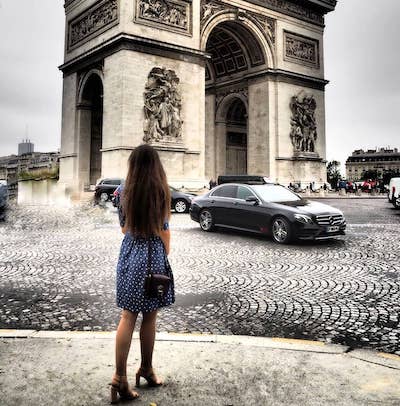

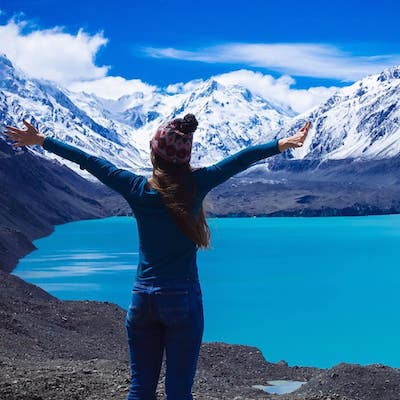
hello, many thanks for your very informative webpage. I am planning to visit this spot in February 2024. For the various day tours, is it easy to book them just a few days in advance or are they easily got fully booked.
Apart from a tour to walk up to the base of the torres for a close view, can they be easy seen on the route along the shores of Nordenskjord Lake or further from Sarmiento Lake?
thanks.
Thanks, for this extensive guide and sharing your experience. Definitely will read your other posts!
Looking forward for my first trip to tdp in Jan 2023 🙂
Hi! Thanks for the very informative article 🙂 I am wondering if the park (W route) is open for solo travellers in the off season? I am looking to go in mid-September, but the limited information I have been able to find seems to suggest solo travellers must have a guide – or go in a group. Thank you!
Hi Robert! I haven’t heard about any difference for solo travelers vs traveling in a group tbh, but maybe they implement it suring the off season only? In any case, I would call and ask the part or one of the refugios, they will be able to give you more hands-on info! 🙂
Hello – lots of fantastic information – thank you. We were thinking of staying outside the park in a cabin, driving into the park, finishing the hike and go back to the cabin at night, The cabin is approx. 18 miles from the park, so not much driving time. This way, we can also cook for ourselves as we have dietary restrictions and are vegetarians. Is this a good option. also, we dont have to carry too much weight in our backpack with this option
Secondly, we want to do the W hike as three different day trips – one day to see the Torres, the other day to do the glacier and hike. We are not sure how to do the middle section of the W hike yet – do you have any recommendations?
Or is staying outside the park too complicated and it is best to stay within the park,
Thanks.
Hi!
Doing day trips from outside of the park would definitely be possible for the beginning and the end points of the park, but I am not sure if you could reach the middle without staying there or taking a helicopter or a boat? I did all the 5 days so it would be hard for me to say, try asking them directly through the official website.
Have a great trip!
HI
Thanks for all the great info! So please just confirm a couple things. I would need to bring in gas to the Refuge Grey and Grande Paine if I wanted to cook my own breakfast and dinner correct? They don’t have gas stove tops for you at these sites? This is different for me as the shelters in New Zealand did have gas stoves to use for the hikers. Can USD be used to buy food for snacks and wine at night? Thank you in advance.
Hey,
Yes you should bring you gas oven with you. There are some hotels that sell ovens but they’re quite overpriced, so I wouldn’t recommend buying from there.
USD is mostly not accepted, so it’s best to have a credit card or Chilean pesos in cash!
Have lots of fun in your trip!
Hi Yulia,
This is so helpful! Thank you! Do you know what the cancellation policy is for the campsites and refugios? Some friends and I are thinking about doing this hike, but if the weather looks totally atrocious the entire time we were thinking about changing our plans last minute. (I know it’s really volatile so we should definitely expect some bad weather no matter what – we just wanted to get a sense of how flexible our plans can be here).
For Fantastico Sur the cancellation policy states the following ”Individuals: 1-9 people, 31 days before check-in. Groups: 10 or more people, 61 days before check-in.” You can check out the exact procedure on their website!
For Vertice Patagonia, their Terms and Conditions that you will find after you fill in the details for your reservation state that you can cancel it with 31 days in advance.
Please double check this information when you book your trip, they could update/change it!
Anyway, I hope you’ll have a great weather and a great time there!
Hello, Are there any restrictions in number of nights to stay in the same Refugio? I booked 3 consecutive nights (one by one, in different times) in the same place. Thanks!
Hello,
As far as I know there isn’t, if you managed to book the days everything should be fine!
Have fun!
Hi Yulia,
Fantastic comprehensive info about TdP distilled in an easy-to-use format! We plan to spend about 4-5 days in TdP post-Antarctica cruise in Jan 2020. The W trek seems the logical choice. Probably Ushuaia-PN-TdP-El Calafate-Buenos Aires is how we will do it. Thanks a lot for your excellent helpful guide!
Hello, Thank you for this post! I understand that reservation camping or refugio accommodations is mandatory. However, I’m having trouble finding accommodations for November 2019. How far in advance is it possible to book reservations? I can’t tell if the locations are already fully booked or if the reservations have not opened yet.
Best,
Brooke
Hi, Brooke,
It is very possible that the reservations are not open yet. I read that they usually open up in May for November-March season. If you want to be extra sure about the situation, you can e-mail the different camping companies or just write them a message on their Facebook pages.
So from So from what I understand I have to order a ticket for the same route I want for example w and then book the camps?
That’s the process, yes, but before that make sure you check that every campsite where you wish to stay is available for your dates. If not, try on different dates. After you’ve seen that they’re all available when you need them to be, you can go back to order the tickets and book the camp.
Have fun!
Hiya
Do you know if you can just access boiled water in the camps? I just want a cup of tea without carrying a stove etc! Thanks Zoe
I think there were stoves there in the camp, though I am not 100% sure.
Maybe someone else here can confirm for Zoe?
Hi Yulia! Thank you for the info! So much great detail.
I am planning on going for 10 days in late March 2019, and haven’t booked anything. Do you think it would be possible to book the W campsites, meals and tent once I arrive there (only a few days in advance)? I am traveling alone and was hoping to meet people at hostels that would join in, or go in a group somehow.
Thanks!
Safe Travels!
Hi Becka, so awesome you are doing it!
Honestly, I cant tell you for sure – i have been a couple of years ago and it was fine-ish to do it almost lsat minute (not in the highest season though), but i dont know about now, I have heard that it is more busy now.
Maybe someone else can comment?
Thank you Yulia for writing and sharing such an informational blog. I have been nervous about my up coming Patagonia trip as I haven’t planned or booked or trained for it yet. I am 3 weeks away. I have hiked EBC 2 years ago but with a porter and done Machu Pichu using porters as well. I was nervous about carrying a backpack and setting up a tent for the first time without the help of porters. Reading your blog and seeing the pictures you have posted brought me a great deal of relief. It looks doable after reading your blog. I read a few blogs before your but yours answered a lot of unanswered questions for me. Thank you!
You are welcome, I am so happy it was useful! Please come back again in a a couple of days, there is going to be even more information in an updated post!
Have a great trip! 🙂
Hi! This was so helpful and I really appreciate it! Me and my boyfriend are going to Patagonia for 10 days. Since we are not experienced (we are pretty active and athletic though) we are not doing any camping that is overnight. Instead, we have booked 2 lodges (Remota lodge and Camp Patagonia) and both places organize day trips and excursions for us, but we are always coming back to the same place in PN to sleep. Do you think we will still be able to see some of the sites that you saw considering we are only doing day excursions? We have already booked but I am worried now after hearing about the W and O treks that we are missing out :/ Wanted a perspective of someone who has been!
Hello Shan,
well, it is really hard to tell as I am not sure where are the refugios you are staying and what hikes you are going to take.
I assume that if the trip is organized, you are going to visit some beautiful places? but if you ask me for my personal opinion, you will experience much more if you will take a multi day hike, you will feel the National Park much better, not sure if you understand what I mean. Spending 5 days there was definitely a lot of fun and we met many great people!
Thank you! This blog was extremely useful! 🙂
You are very welcome! 🙂
PLEASE GIVE SOME INFO ABOUT EASTER ISLAND AND ATACAMA DESERT.
THANKS
DR NILESH BAXI
I havent been to all the places in the world yet, that is why the blog doesnt cover it.
Easter Island is my dream for now, I am planning to visit at some point.
I cant say much about the Atacama desert, we did stargazing and it was wonderful. I have then cough a very strange allergy to their dust or something and we had to leave.
This article is a treasure. I was looking for a long time to find somethings like this. The details are awsome and finally the claer routes map. We will definitely use all your advises in plannign out trip.
Спасибо огромное за труд и советы!
happy it was useful for you!
Have an amazing trip!
всегда пожалуйста)
This is the best Torres del Paine guide I ever read. It’s just perfect! Great job!
Thanks Nihan! <3
Yulia, your guide is very useful and easy to understand. I am planning my trip to W trek in January 2019. Before I still have some hesitation should I go. I am 62 but I am phyically fit. I was able to finish the Laras Trek, Peru last year.
If you are in good shape, I am sure you will be fine, so not worry! I havent done the Lares trek, but I have heard it is quite challenging!
Yulia, your guide is easily the best in the whole internet! I’m planning a solo photographic expedition for 2019 summer and almost all my questions are answered for you! Thanks! I’m just wondering if the free camping sites works well in these days… I’m planning the cheap option because i need the most immersive experience possible.
Hello Hemerson,
I am happy you liked the post!
As for the free camps, everything should work as described, but as I said, you need to book in advance.
I suggest calling them when you arrive to Puerto Natales from your accommodation.
Have a great trip!
Very useful information!! one question, what side could you recommend for One Day Trek?
The actual Torres trek 🙂
Just booked our trip today for the first week of April! Only staying in the park for 2 nights so planning to do part of the W trail. Great information for us to work with! We are planning on bringing our own gear, tent, and food but might need to stop by the hostels for some wine and a dinner!!
Well wriiten. Very informative.
Hi Yulia, what entrance did you use for the park? And what were the overnight stops you made along the way? I found many options and do not know which ones to choose.
If you could share your full itinerary from start in Puerto Natales to return in Puerto Natales, that would be great, thanks!
Thank you, this was very helpful.
I AM PLANNING W TRUK. HOW MUCH TO WALK EACH DAY.
PLease read the post, everything is described there.
https://misstourist.com/wp-content/uploads/2016/06/hiking-trail-time-Torres-del-Paine.jpg
Hey, this is the best information that I have read. I am heading to Patagonia in December. Thank you for blogging this article on Patagonia. I am an avid traveler and I like to do a lot of research and independent touring on my own. You are really good at putting your travel details in a concise manner. Love the pics!.
Happy it was useful! 🙂
Hi Yulia, your blog is a great resource I’ve found on . I am going in last week of october ( flyin to Santiago first ) and from there to Punta arenas . I have never been on hiking trip , I did a few hikes in NZ last year but they were all day trips/hikes. Would you recommend this hike for someone who is not experienced ? Also – to book the hostels do I have to book them through fantastico or vertice, is there anyway I can book them myself? $1k for 4-5 nights in bunk beds seems a little high . Also for the W treck do we keep going in onne direction for 4 days or is there a base point where you keep your stuff and take day trips ? thanks in advance
So funny, i am planning my trip to NZ now! 🙂
Yes, i would recommend it to people of all ages and all levels. It might be not that easy sometimes, but it is doable if you are relatively fit.
Yes, you have to book them either through the official website either whatever system you prefer (booking, expedia etc)
The prices as I mentioned are very high, you can make it more affordable by staying in tents.
I left my stuff in a hotel in Puerto Natales, this is a normal practice in the city. Most of the times you will have to carry everything with you that is why you should pack as light as possible.
have a great trip!
NZ is awesome , you’re going to love it . Would u suggest staying in P. Natales and take day trips ? is there anywhere else I could go in that area ? I will have 7 days after I fly into Punta arenas.
thanks for replying 🙂
Hee Yulia,
Thanks for the useful information!
One more question
Can we recharge our camera at the camps? (we are camping all the way, 0 circuit)
Rianne & Ted (Netherlands)
You can do it in all the refugios, in some of the kitchens areas of campings, obviously not in the tent if you will be staying there.
Hi, Julia
Thanks for sharing your experience!
I am going to do a solo hiking on October. Do you think it is safe?
Thank you!
Very safe, no worries!
Hi Yulia! Great information on your blog, thank you! Question: for the park entrance fee, do we only pay once upon entry? How long is the pass good for? How does it work? Would really appreciate your advise. I am headed there in a few days 🙂
Yes, you only pay once when you enter.
Have a great trip!
Thank you thank you thank you for this article! Is there any way that I might be able to contact you by phone. I am planning a trip and I have more questions.
Rudy
Hello,
I´m just plan my O trip, I want to do it in October, BUT! I can´t book the campgrounds thrue these websides (Conaf etc.) I don´t know how, it´s looks the O trail is open since November. Do you know something about it? It helps me so much. Thank you,
T.
I haven’t done the “O” unfortunately.
Maybe somebody else knows?
Hi Yulia,
Thanks for the informative tips! This was by far, one of the most helpful guides I have read about Torres Del Paine. I’m planning to go there in September.. hopefully the weather won’t be too harsh then! Keep up your awesome blog. Happy trails! 🙂
You are very welcome!
Hope the weather will be nice to you! 🙂
How much of a buffer should we leave between our flights and the beginning/end of the trek? I was planning to simply fly in the day before the trek and fly out the day after the trek, but am unsure how realistic this is given the length of time it takes to get between Puerto Natales and Punta Arenas. Any advice would be greatly appreciated!
While it is possible to arrive the day of the trek (in the morning) and start right away, i would still recommend taking a day before the trek – to do some shopping, to learn more about the trek. I’ve heard there are some restrictions about the number of people per day, you should check that as well (when i visited, there was none).
If you are an experienced tracker and you come prepared, I see no reason why not start the trek right away.
As for the last day, there is no problem to leave right away.
Hey Yulia,
thanks for this superb and funny information! 🙂
You qrote that it would be cheap to camp with the own tent, but I’m wondering where to find cheap rates… At least Cuerno and El Chileno are up to 70$ withou the choice not to take the full board :-/
Do you have any recomendation?
Best,
Yannic
Hey Yannic,
I am afraid that is what cheap is in Torres del Paine 🙂
A year ago when we rented a tent it was about 60$ for 2 people (not including the food).
In order to save money you can have your own tent, but you will have to carry it around with you all the way.
Such a useful guide! Thanks very much. Just wondering…how did you get down to Patagonia? Me and my boyfriend are thinking of heading down from Santiago but will it take too long if we take buses?
hey Nicole, thanks a lot!
We took a bus from Bariloche. it was a quite exhausting and very long ride (30-something hours) and also not that cheap. If you can, book the flights in advance, it will be the same price as the bus and waaaay more comfortable!
safe travels!
Hi, Does anyone know if you need to buy the entry ticket in advance anywhere? Or do you have to pay the entry fee when entering the park? (I read somewhere that there’s a cap of 80 people per day allowed into the park, and since I already reserved all the camping spots for my 7day hike, I’m curious if you need to buy this in advance or not).
Anyone who has been there recently, let me know how the procedure is now, since they seem to have changed the rules quite a bit over the recent years. Thanks in advance!
hello Sebastian!
The rules indeed changed quite a bit even despite the fast I have been there less than a year ago.
I can assure you the limit is not 80 people a day. Moreover, as the official site states right now you can only pay in cash for the entrance, no online entry ticket can be bought.
Have a great trek!
Hi Yulia, I would like to agree with Sonja and stress the point. The regulations have become much stricter than what you describe from last year: places in the free camping sites are fully booked months in advance, and even the paid options are completely unavailable (you need to book at least 3 weeks in advance or be extremely lucky).
Since this is a very expensive place to get to (in terms of both time and money), it is important to know in advance that a spontaneous visit is (almost) impossible.
Hi – a fantastic summary with so much useful information – thank you so much. One question, can you buy park entrance tickets in advance?
Thank you!
No, you have to pay in cash at the entrance!
Fun girl, thank you for that nice blog. Wish I can cross your path, going west to east In February. Good tips here, will be fine, thanks
Hi Yulia, thanks for that very helpful info!! When have you been there? Do you know about this new rule that you have to book all your campsites in advance? Otherwise you are not allowed to enter the park
Sonja,
Thanks for the information, do you know if this rule exists if we carry our own tent ?
I can’t find the answer ! Thanks
I was there in February 2016, and it wasnt like this last year, thanks for the update!
Awesome blog about Torres Del Pine! The best I have seen!
We are going to Chile and Argentina this December.
Spasibo, Yulia! Super post! Vi otlichniy pisatel’, vse razlozili po polochkam!
Best,
Viktoriia
Glad if it helped you guys to prepare for the trip! Safe travels!
Viktoriia, spasibo bol’shoe za kompliment! 🙂
Hi Yulia,
I’m going to hike the ‘W’ and will be carrying my own camping gear. I have been able to make reservations for every place except for at Los Cuernos. Will I not be able to camp and set up my tent if I’m unable to make a reservation ahead of time there? Thanks.
I was just told that it is required to book your campsites in advance.
If you cant do it online for some reason, I recommend calling the property and booking it by the phone, there should be no problems with that!
Hi Yulia!
Thanks for all the information! I was wondering if you went recently and the free camps being open for reservations only a day before was still true? I am trying to reserve the spots online, but it is saying I can’t due to no accomodation being available. I didn’t know if this was because a) they were booked or b) they do not reserve that far ahead. I have reservations on the O circuit until Los Perros, but then I have nothing and I wasn’t sure what to do about that. Let me know if you have advice or tips!
Thank you!
Hi Melissa, I was there in February 2016 and the rules were slightly different.
I recommend calling the property directly to ask them to book a spot for you.
Hi Yulia, I am planning on carrying my own tent and camping in the free sites. I was wondering how far away the free sites are to the refugios if we wanted to buy meals. Thanks!
Hi Ashley!
No, free camps are just a stone throw away from campings. It is specially done this way so that people could join facilities if they wish! 🙂
I love the secret code 🙂 Looks like an awesome hike!
Thanks! It is, you should do it!!
Thanks. It’s very useful information.
Welcome! 🙂
Thanks for the info!
Well done reference. Best I read.
Fantastic info!! I have spent so much time taking and searching to gather necessary info and main result was frustration until I came across this blog. Very well written and very informative indeed. Thank you!!
Hi Yulia!
I am planning on going in January or February of 2020. How far in advance do you recommend I book my hostel?
Thank you so much, this was a great read!
Hi, Deborah,
Thank you for your nice words! As I always say – the sooner, the better! 🙂 When you’ll know for sure the period and the number of days you will stay there, I think you can proceed and book your hostel.
Have a great time in Torres del Paine!
Hi, I really want to know if I’m in Calafate and I want to go but like in a trip of just going into the park for 1 day can I? what would you recommend? I’m doing a 20 days trip to Argetina in December and I wanna know what I just can’t miss!
Yes, you can do a day trip if you want to. I recommend the main one – visiting the torres
HI, great read , I am going later this month and havent planned anything , if I wasn to do this on my own , is there a list of stops ? so I know what places to book and do you recommend doing this on your own or taking a guided tour ? thanks